#the bus is my least favourite of the 3 public transport options but I still love the bus
Explore tagged Tumblr posts
Text
I love to take the bus because I can play on my phone (and get so so motion sick) and don't have to park. I need to take the bus more often because it has become dark and everything is unrecognisable and I become panicky that I don't know where I am. The bus does not go the way I drive. However I just passed my normal supermarket. I have passed through the shadow of the valley of death
#pay attention to what's going on around me??? no thank you#the bus is my least favourite of the 3 public transport options but I still love the bus#I don't have a tram that goes to my house#honestly trams aren't really better than busses but one can feel snobby about one's tram network#I for one would not nuke the trams#also today the bus came right when I wanted it to so I'm high on life (I did have to throw myself in front of it a little bit to get on)#I was not high on life earlier today but now I am
4 notes
·
View notes
Text
Have you got your tickets for UV locked down? Maybe you are like me – tickets bought but not all other details finalised. Priorities, right? The most important consideration is to make sure we get to see RA on stage. Flight? Accommodation? Can be dealt with later. On the latter, I’ve had a few questions bts about hotel recommendations. Now, I do not want to presume better local knowledge than all the English/British fans. However, as a frequent visitor, and particular while I was still working for my London client, I was put up in hotel accommodation on many occasions. In that sense, I may have seen more London hotels than our actual London-based fan sisters *waves at Hariclea and tinyclanger and anyone else whom I am shamefully overlooking here* and can possibly make some recommendations.
A quick note on location and transport
My collection of Oyster Cards. Yes, I’ve had to buy several because I stupidly left mine at home… They give you a little wallet for safe-keeping when you buy yours.
All hotels are fairly centrally located – if you are a walker and do not mind 45 minutes walking, they would even be in walking distance of the city centre of London. Transport, on the whole, is not a problem in London. The tube is never far away. I recommend you buy a so-called Oyster Card upon arrival in London. This is a commuter card that you load credit onto. You can buy it at any (larger) tube station (ticket counter). You can get the £10 deposit back when you return the card before you leave London. You charge your card via the ticket machines located in every tube station. Paying for the tube is via flashing the card at the gates for entry and exit. A display at the gates will always tell you how much money you have left on your card. An Oyster card is a must, even if you only stay for three days. The difference in price between buying single tickets and using your automatic card credit, is significant: A single journey will set you back £4.90 whereas the Oyster card is £2.40!!! Also, the Oyster card has an automatic cap. That means you will pay a maximum of £8.20 (zones 1-3) versus single journeys or a daily travel card at £13.10 (zones 1-4)!!!
However, the best tip when it comes to London public transport, I received from local Hariclea: Bus fares are much cheaper than the tube. A single journey will set you back only £1.50. The daily cap for Oyster Card here is £4.50. So if you can, take the bus. Or walk, that is *my* personal tip. For a long time on my travels to London, I did everything by tube, thinking that London was a huge city and everything was very far apart. It took me 3 years to realise that Piccadilly Circus was only 250 meters away from Leicester Square! Doh. So make use of Google Maps and walk. You will be rewarded with a fantastic view of the city, too, because London treats you to a journey through all architectural ages in almost every street.
Fleet Street. From Tudor half-timbers to 1920s in 500 meters
Guylty’s Hotel Insights
I’ll give you a little review of all the hotels I have stayed at in the last four years. A caveat at the beginning. At least half of them were paid for by my client – and they didn’t skimp. I would not have paid £350 for a hotel room myself. My budget – even while still employed by them – would usually not stretch to that. However, I am including it here, too. Who knows, maybe you have a significant birthday/anniversary, or you want to treat yourself to an extraordinary London experience. Or maybe you just appreciate a lovely boutique hotel, just like I do. Where possible, I will add my own pictures – and occasionally even videos – for a little more insight into the hotel. Links to the hotel website under the name. In no particular order…
Pop!Thoza sneaks up on breakfast
The Rookery – my absolute favourite, but the above mentioned luxury option. Located in Farringdon, opposite Smithfield Market – a boutique hotel completely furnished with antiques and with every room looking different. Close to two tube stations, near the Barbican centre, too. It really looks like the photos on the website – or in my videos. Yep, I have three of them, just because the hotel was so beautiful, I had to document it every time. But I’ll only bore you with one of them. (If you want to you can see the other two if you click on my name on the video below!) This hotel has beautiful common rooms but no breakfast room. So if you want dinner, you need to eat elsewhere. Breakfast is available – but only served in your room. However, it was not any more expensive than in other hotels, and at the same time so good that I always set the alarm for two hours early so I could have long, leisurely breakfast in my fluffy bed before I went to work.
https://vimeo.com/133549399
Purple light show. Not sure what mood *that* is…
Citizen M in Southwark (Bankside) is completely at the opposite end of the style spectrum. Ultramodern hotel. Every room has a kingsize bed (no single rooms available) and lots of tech gimmicks. Has a fantastic entertainment offer with wide screen TVs in every room. You can operate different lighting scenarios with an iPad in the room, and the blinds are automatically adjusted depending on whether you have set the room settings on “romantic” or “business” 🤣. Located behind the Tate Modern, but still very central. I loved this place and stayed there a couple of times privately, too – my son called it the “cyber hotel” and specifically asked me to book us in there when I gave him a trip to London as a gift. He (age 18 then) even shared the kingsize bed with me – that was the price for being in the cyber hotel… Buffet style breakfast is available in the hotels bar area. I loved the cool style and design of this hotel.
The Park Plaza County Hall is also situate d on the Southern bank of the Thames. I was upgraded to a suite there – with a separate sitting room and a small kitchenette. Comfortable, modern, light-filled rooms with floor-to-ceiling windows. The kitchenette would be really useful if staying for a few days and trying to budget a little bit because eating out in London is expensive. It doesn’t mean you have to cook – but just having a fridge for a pint of milk for your cornflakes in the morning, would already save you a good bit of money. I did like this one very much and remember making a little video – can’t find it anymore, unfortunately. It is part of the Radisson chain, so good quality.
I slept on top bed – wanted the “young” feel
Z Hotel City Another very modern hotel, centrally located in Fleet Street. The rooms are very modern, but also fairly small. I had a room that was billed as a “family” room with two double beds. But even though the room was tiny, they solved the problem really well: One double bed was like an enclosed alcove (fitted with a big TV) while the second double was built on top of the alcove and you accessed it via small steps. The second double also had a TV screen. The drawback was that the hotel did not offer breakfast, and even though it operated a café next door, it did not provide a discount to residents. However, as you can see from the photo, this kind of room would really lend itself to sharing if you are coming with a friend. Share the costs – still get privacy. And style, too.
No real vines, that’s the graffiti on the wall!!
The Malmaison on Charterhouse Square. Another boutique hotel in Farringdon (like the Rookery above) (near Barbican), located on beautiful Charterhouse Square where you get London at its historic best: There is the eponymous Charterhouse from the 14th century, then there is Georgian architecture, the Victorian hotel building, and an Art Deco block of flats (which was used as location for Hercule Poirot’s flat in the Poirot TV series with David Suchet). Every room differently decorated – modern eclectic. The rooms were small but beautiful and all decorated differently. The first time I stayed there, I had an “inside” room with a kind of blind window into a lightwell. The room had really funky decoration with a graffiti-sprayed wall. Breakfast was not included but available in the basement restaurant – really nice, though.
Glimpse of room on the right. Bathroom had massive dimensions. Wheelchair compatible
The Premier Inn County Hall is probably on the affordable end of the scale. Centrally located, directly behind the London Eye and more or less directly on the banks of the Thames. The rooms were not particularly cosy or original, but clean, light and big. Probably more on the practical side. Prices are pretty good for London – and for the location. Breakfast available in the hotel – nothing special, but good price.
You can see what I had for breakfast
The Marlin Aparthotel was an affordable option when I took my mum to London last year. This hotel is fairly well connected, just behind Waterloo Station. In walking distance of the Old Vic Theatre and Westminster on the other side of the Thames. The rooms were bright and modern – and they came with a kitchenette. We ate breakfast in our own room every day and saved on another tenner for meals that way. This hotel is easily accessible by bus – which will also get transport costs down…
Lastly, The Grange Strathmore Hotel is the last hotel I stayed in when in London in April this year. The building is the former residence of the Earl of Strathmore (the Queen Mother’s father), and as such an imposing Victorian residence in a very pretty part of London. The room was small and looked out onto the mews at the back. Kensington is a very nice area for walking and looking at the grand white townhouses, but it’s not as central as the other hotels listed above. Also, I didn’t find the transport options quite as close as the other hotels.
So, here is an overview of the hotels and their relative location. It’s an interactive map – you can click on the markers and see which hotel it is.
That’s it for my own experience with hotels in central London. As I said – not necessarily the cheapest *thanks to my former employers*. I am sure there are other, if not better options available. If anyone has some recommendations, please add them in the comments! And for further questions – I’m delighted if I can answer, although I am sure that the resident Londoners are probably better equipped than I am.
Leaving you with a little London Lucas for good measure.
Notes on Staying in London Have you got your tickets for UV locked down? Maybe you are like me - tickets bought but not all other details finalised.
9 notes
·
View notes
Text
What I Learned From University (1st Year)
FIRST YEAR
Everyone is super friendly, especially in the first few weeks → Introduce yourself to the people sitting near you for the first few weeks of lectures. Everyone is looking for a friend or at least someone to talk to!!
If you commute, make that time productive → My bus ride was an hour there and back each day. It sucks but I would try to be productive for at least half of the commute. I have a post about being productive on public transport here.
On that note, stay on campus as long as possible each day → As soon as I got back home I would procrastinate every little thing. Stay in an already productive environment for as long as possible.
Maybe don’t buy your textbooks used → I thought I was being smart by buying used textbooks (most schools will have a buy and sell facebook page for textbooks). I ended up having to pay for access codes in order to do my online homework – access codes that cost ~$70 separately and came included with new textbooks anyways. Email your prof or talk to someone who has recently taken the class to find out if you need an access code. If you do, your best bet is to buy a new version of the textbook (unless you can get a seriously cheap used textbook).
Print off your timetable and find all of your classes before the first day → This helped me so much! I found exactly where all my classes were before the first day of class. I wrote down little tricks to help me remember where everything was (i.e. my calc lecture is in the arts and science building which is also where the only subway on campus is).
Don’t knock living at home to save money → If you’re lucky enough to have a college or university close to home at least consider living at home. Getting your own place or living in dorms is expensive. (But if you have to find off campus housing on your own, don’t leave it too late or you might not find a place)
Figure out the best way to take notes for each class → You have to customize the way you study for each class, all depending on the prof and the content. I hand-wrote notes for some classes (chem, calc, and physics), but not others (psych and bio). If you’re writing by hand you can always just annotate your textbook notes or lecture slides (if they’re posted before class). If you fall behind while taking notes, just leave a gap and check out a friend’s notes after class.
Adjust your expectations → Don’t expect to get straight A’s, like you might have in high school. You can strive for straight A’s but be realistic as time goes on. For classes I struggled with, I expected to be near the class average. If I was a lot lower than the class average then I would know to invest more time.
Make time for physical activity → If we’re being honest I hardly exercised during uni. Go for at least a half hour walk each day and try to start a physical activity routine. Get a friend and join a sports team, go to a fitness class, or commit to some form of a daily workout with them! You’ll feel bad bailing on someone else, plus working out is more fun with other people.
Review content throughout the semester → Reviewing little bits of content will save you a massive content review right before finals! Look through old notes while you wait for your daily coffee or take 15 minutes to watch some khan academy videos on stuff you learned in the first month of classes.
Think seriously about how much you can handle → Don’t take on too many responsibilities at once and consider all of your options! I worked weekends and some week nights throughout the school year. Looking back I should have worked less because my stress levels were way too high. Also, quite a few people I talked to took 4 classes instead of 5, for their first semester of university. I don’t think I would have done it, in the end, but it’s always something to consider.
Have fun but be responsible at parties → Always go to parties with people you trust!! If you didn’t do much partying/drinking during high school (like me), remember to pace yourself when drinking! Eat before you go out and have some water between each drink, till you find your limit. Don’t let yourself be peer-pressured into anything but also don’t be afraid to have fun! And check out if your uni has a safe walk program (someone will come and walk you back to your dorm or your car if you feel unsafe or nervous for any reason)
When procrastination hits, aim to be productive in some way → The only reason my biology mark was so high was because I would study biology whenever I got sick of studying for physics and calculus. If you know you need to study but just can’t do it, start by being productive in some other way – study a subject you do like, do your laundry, organize your study area, etc. Get your brain to start thinking productively.
Labs are difficult so be prepared → I had so many labs first year. Some tips: eat and hydrate before labs, never assume you can finish your prelab last minute, be nice to your lab partner, always remember lab safety (don’t be the person trying to wear shorts in the lab, TAs will not hesitate to kick you out), don’t rush through an experiment but be efficient, and ask for help (even if you feel like you’re bothering your TA).
Please go to bed early. Sleep affects everything → I was so dumb and would never go to bed early even though I had to be up at 6 am almost every day to catch the bus. Lack of sleep will catch up to you eventually!! Also, all nighters are not necessary, unless you make them necessary. I prioritized and never had to stay awake too late. And never pull an all nighter the night before an exam (you’re better off getting sleep and resting your brain).
Bring a water bottle everywhere → Buy a decent water bottle and always carry it with you. Even though my uni is small there are still tons of spots around campus where I can refill my water bottle!! Stay hydrated my friends!
A practice problem a day keeps the F away → This saying probably works best for science classes, but I guess a reading a day will get you somewhere too. Do something for every class each day, even if it’s just a practice problem or a quick reading. Develop a routine!
You’ll have lots of midterms → I was under the impression that midterms happened just once a semester (I thought I would have one week where I had a midterm for each class). That was not my reality. I had 2 or 3 midterms for each of my classes scattered throughout the semester. Study really hard for your first set of midterms till you get used to the high expectations!
Don’t worry about what other people are doing or thinking → This is mostly in regards to social media. I was bummed when I looked back on my first year of university, because I felt like I hadn’t done anything fun compared to other people. You only see the image that other people want you to see. You don’t know how hard someone worked or how hard they didn’t work. Just focus on you and how you can affect positive results in your life.
Other people literally don’t care about your appearance → My friend’s little sister visited campus and asked us “Why is everyone wearing sweatpants?” People literally don’t care. Dress nice and put lots of makeup on one day, because you feel like it, and wear sweats the next day.
Start essays and reports as soon as possible → You never know what might come up so be prepared for the worst! Outline your essay or graph your data as soon as you can.
Eat healthy and do meal prep → You can eat healthy during university! Set aside a couple of nights each week to do meal prep. Cook food in bulk to save money and don’t eat out too much. Try to have at least 1 serving of fruits or veggies with each meal or snack you eat!
Find a good study spot on campus → Explore your campus and figure out your favourite places to study. I had a couple of spots where I would always meet my friends to study and quiet spots where no one would bother me. Studying outside or in an area with natural light is always good.
Don’t be afraid to talk to your profs and TAs → This is the number one thing I’m going to try to do more of in my second year. TAs are chill to talk to and they can tell you tons of useful information on what upper year classes are like, which professors are good, why they chose to go to grad school, etc. If you’re struggling in lectures or labs, talk to your prof or TA! Make an appointment and be sure you can tell them exactly which concepts you’re struggling with or at least where you got lost. One of my profs told us he just waits hopefully during office hours for someone to come in. (Also profs love it if you ask them about their research or any topics they seem passionate about during lectures.)
Explore all the resources your university has to offer → My university has a program that is basically people bringing their dogs around for students to pet, in order to relieve stress. It actually works and gave me something to look forward to! Just be aware of your options so that if something in your life changes you know where you can go to ask for help.
Get a planner and utilize it → There’s no excuse not to have a planner of some sort. Use your phone, get a bullet journal, or buy a cheap planner. Have somewhere where you can record important deadlines and make to do lists. I also recommend back planning all of your studying at the beginning of the semester. Write down your midterms and finals dates and write down how much you’re going to study each day leading up to the exam. This way you’ll be able to look ahead at each month and figure out what needs to be done (i.e. getting an essay done early because the due date falls during a busy week of midterms)
This post ended up being a lot longer than I expected whoops. Take the things I said into consideration but remember that everyone’s experience will be different. Good luck to everyone heading to university!
My Other Posts:
AP lit tips
high school biology
organization tips
physics doesn’t have to suck: how to enjoy and do well in your required physics classes
recommended reads
reminders for myself
using your time wisely on public transport
what i learned from high school
#i hope this helps anyone entering university or college!!!#it will be stressful but you can do it!#studyblr#etudiance#academla#studybuzz#studyplants#elkstudies#heystudiyng#focusign#areistotle#idkstudyblr#intellectus#natlookhere#mine
4K notes
·
View notes
Text
Rules: Answer the questions you’re given, write 11 of your own and tag 11 people.

I have had the pleasure of being tagged three (3) times for this sweet, sweet meme so brace yourselves, apparently you’re gonna learn a ton about me today! Placing it under a cut because.... you should really be thanking me, honestly.
1. it’s late in the afternoon and you’re in a new city. do you take the train, the bus, or do you walk to get back to your place?
Am I just moving to this town? Likely, I’ve probably visited before so I would have a sense of how to use the transportation. Or, Google Maps is pretty handy! I actually enjoy walking most places if it’s available to me; otherwise, I’m a train kinda girl. I’ll take the bus if I have to. I’m very positive towards public transportation and energy efficiency. Reduce that carbon footprint!
2. what’s your dream place to live (city or country? continent? in land or by the sea? cold or warm?)?
Okay, but... gonna go cheesy and say with my loved one. ‘Cause I’d honestly survive with any climate as long as I’m with them.
Assuming I’m single af and forever alone, or at least living on my own for a while? I’m definitely a larger city kind of girl, or near access to a large city. I wouldn’t mind living in a suburb and then commuting to the city, actually. I love nature, but I don’t want to be isolated in it for too long. I spent three months in a literal jungle. I’ve had my share of country times.
Also, having lived near Wisconsin-- I am way over the winter. I’m fine if I don’t see a lot of snow. I actually do enjoy rain, though.
3. what’s one of your favorite threads across any of the muses you have ever played?
One of the earliest threads I’ve written on this blog was with @argentnoir & it was just kind of like a slow burn / pining kind of deal? Where Tseng acknowledges that Yuffie is up to be empress of Wutai and how inappropriate it is as one who has actively abandoned his nation that he would support her. So he tries to deny and reject any feelings which might surface for her, while Yuffie is very much a “ forget protocol, I like you. ” I really liked that dynamic of how Tseng knew what was right for the nation even if he no longer belonged to it, and Yuffie was very “you belong to me, therefore you belong to Wutai.”
I’m weak for Tsuffie okay like let me die with this ship.
4. five songs you’d love to share with people?
manzions // gorgeous. while my apartment was being renovated a few months back, i rented a room in an ex-friend’s house ( we were cool in high school but after that we grew apart ). anyway, the walls were paper thin & whenever i was depressed or crying or something, he would always play this song.
joji // will he. okay but a surprise twitter bop? also let him move on from his previous persona ok. yeesh. people are allowed heelturns. anyway, so this song is so mellow & i dig it, but also it just reminds me of the type of music a friend of mine used to send me all the time when we like... stopped being super close. that was their way of reaching out, was sending songs. and like. idk joji’s character / the lyrics super just make me think of that friend ‘cause that’s definitely what that friend would say to me, if he felt confident enough to ever use the words.
yakuza 0 // 24h cinderella. this is a guilty pleasure song. in case y’all didn’t know, i love rgg / yakuza almost as much as i love jojo ( that’s saying a lot ) & majima makes my life better okay. i am annoying & go around singing this. i’m pretty sure i’ve sang this like every week since release. i probably could use some help lmao.
utada hikaru // forevermore. don’t sleep on this song. idc if you didn’t see the show. i know everyone’s still screaming about omen / don’t think twice but i’ve been screaming about forevermore since she came back from retirement. bless hikki. also here’s a tissue for your eyeballs.
yumi kawamura // burn my dread. before we were shook over lyn inaizumi & shihoko hirata, we were all dying over yumi. who, by the way, is my literal queen ok. every time i see a persona concert online i sob profusely when yumi is on stage. i own the p4d soundtrack & i sobbed through her tracks on there too. honestly that was my most played music of 2016, that soundtrack. her voice is beautiful in every song, but i had to pick one, so why not the intro to p3 so we can all sob profusely. you’re welcome.
i would’ve put sono chi no sadame but i need to be tamed. i will, however, put the link to jojo’s first six intros performed live, though. that’s a real masterpiece that should go on the big screen. man, what i would do to go to a jojo concert.
5. are you good at math? (if so, why are you a nerd?)
i am rather proficient at math, actually. i wanted to go into medicine at one point, then psychology. you need a background in statistics to do that. but i also showed an interest in calculus, despite being terrible at physics and three-dimensional art. i studied it into high school, but gave it up in college to pursue language and fine arts instead.
6. were you a goosebumps kid or an ‘are you afraid of the dark’ kid?
goosebumps. though i’ll admit i read the books more than watching either show.
7. how many tamagotchis did you own in the past, and what were their names (if you remember)?
i never had a tamagotchi. or a neopet. that’s a whole era that goes right above me.
8. what’s one situation you want to / wish to write your muse in?
historical drama.
9. what’s one thing you’re really proud of, either in your portrayal or yourself in life? or both! actually yeah, list two things you’re proud of, one in your portrayal and one of yourself in life! ;)
i’ve survived a lot of tough things, so i guess i’m rather proud of that.
i’m also like... happy that i’m able to pull off a yuffie that isn’t reduced to a sex object. it’s really nice actually to see people more these days seeing her for her maturity & respecting her for the amount she’s able to achieve. even square has backed off with making her such a heavy comic relief, at least in dffoo, and that makes me really happy.
10. pc or apple? (there’s only one right answer to this question, and it’s not apple)
i only own one apple product & that’s a iPad that was given to me during college. which, it was rather useful while i was in school, but i can say i’m not really a fan of the whole “apple slowing down your devices to make you upgrade” thing. also, it’s so expensive? i’d like to get into video editing and photography, & while i’m aware i don’t need an apple to do that, i like the simplicity and interface and hardware. but.. y’all these prices & these games are too much.
also, atm i don’t use either a pc or an apple: i’m on chromebook. & it’s really efficient if you’re into blogging or writing or really minimal things, like i am. c:
11. what’s the most embarrassing muse you have ever played :-)
maximillion pegasus. i wrote him as a joke in high school. i will not bring him back for anything lmao.
1. what season is your favorite in your most favorite running tv show?
i actually don’t... watch television... the last show i tried to actually pay attention to was designated survivor. ‘cause i’m weak for kiefer sutherland. and uh? idk i like it cause it has rising climax !
i also binge watched ghost adventures so.... maybe that counts. uh?? i would say maybe seasons 10-13 were my favorite because i felt bad for billy! always sending billy off on his own & his expressions about zak “can you stop summoning demons for a second?” is always great.
2. if you were apart of a trio like the three stooges, what would your names be (can’t be curly, larry and moe)?
actually, @lockedfighter & @crystarium-rose & i are the powerpuffs. i’m buttercup.
3. you’re a sailor scout, which one are you and why?
i love haruka for her ability to subvert gender roles. i’m really into androgyny & i don’t think my biological sex should limit my physical capabilities or interests. i also have short hair. however, people tend to liken me to ami, minako, & makoto.
4. what is your favorite mode of transportation and why?
jeeps with the doors off ! also tuk-tuk and motorbike. what a thrill !
5. what is a fruit you love but hate any byproduct made in its flavor (ie: grapes, love the fruit but hate grape flavored drinks or candies)?
cherry flavored things are always too strong for me.
6. you’ve lost one of your five senses, which one is it?
uh... smell? though tbh in the transition of winter to spring, it’s a combination of smell and taste because my throat closes off when lilacs bloom & i have to use throat numbing spray lmao.
7. you’re superman for a day, which one of his powers do you abuse the most?
laser vision. burn baby burn, disco inferno.
8. a favorite book you enjoy has comes to life and you are sucked into that world. what book is it and what character are you in that book?
that would be highly problematic considering my options would be the divine comedy or jojo. assuming i’m jojo.... i’d love to be caesar zeppelli when he first meets joseph. that’s quality.
9. do you have a birthday this month, when is it?
my birthday is july 23.
10. i just burnt your favorite dish trying to make it for you, what was the dish suppose to be?
if you burn pasta i’m kind of wary of you tbh.
11. you just got a very pretty parrot, what is the first word you teach it?
“ hewwo. ” i blame apollo entirely.
1. what’s your favourite comfort food ?
gummi bears !!! that’s not a comfort food? then mashed potatoes & gravy. surely that counts.
2. if you could physically go into a video game for a day, what game would you choose and why ?
policenauts because i’m still weak for space exploration. that, or xenoblade chronicles 2 because i need to make friends with mr. turters & zeke stat.
3. what’s the first book you’ve fallen in love with ?
pretty sure it was an anthology of greek & roman mythology because i’m a nerd.
4. what’s gotten you into writing in the first place ?
i’ve been writing for like... ever. i’ve had diaries since preschool. it’s how i express myself.
5. what made you pick the character ( s ) you are currently writing ?
@lockedfighter “ asked ” me into writing yuffie & @kintsuggi asked me about writing paz.
6. what do you cope with better : being cold or being hot ?
being cold. ‘cause i’ll just add socks and blankies & eventually fall asleep. i can only take so many clothes off. and i hate sweating. and drinking water helps to a slight extent but gawd.
7. what’s the one thing you love about your country ?
uh. can i talk about being first nations? great. i love how people who are ndn / first nations respect one another’s differences & how everyone is just “cousin”. that we’re all extended relatives of one another and support people in whatever they might need. i love that solidarity.
8. can you list five things that you love about yourself ?
i’m nice. i care about others. i help others the best i can. sometimes i can be cute. i’m smol & fit into places.
9. what’s your favourite tv show and why ?
24 because it’s action, espionage, justice & i’m weak for kiefer sutherland.
10. if you could change one thing about yourself, what would it be and why ?
probably my body because it brings me a lot of unhappiness.
11. if you could become a mythical creature, what would it be ?
a fairy. i would love to be like navi. “ hey, listen! watch out ! ”
TAGGED BY: @smashkick & @fcragil & @re-no ( this is why people think i’m popular i betcha. )
i do not possess the concentration to ask people 11 questions BUT if you wanna just talk about yourself, feel free to tag yourself in that lmao.
2 notes
·
View notes
Text
Everything I Learnt Backpacking Bolivia in Three Months – A Traveller’s Guide
I spent an unforgettable three months backpacking Bolivia.
Bolivia is one of the cheapest countries in South America for backpackers – particularly compared to its neighbours in Chile and Argentina. Many visitors travel Bolivia for the Salt Flat deserts, the witches markets in the breathlessly high city of La Paz, and the mysterious Lake Titicaca – the world’s highest navigable lake.
But there’s so much more to see in Bolivia.
I chose to spend three months backpacking Bolivia, and my Bolivia itinerary was scattered and circuitous. I volunteered in La Paz, fell in love in Sucre, drank local wine in Tarija and stepped inside dinosaur footprints in Parque Torotoro. I danced under the full moon beside Illimani mountain and lived in a tiny village without running water. I hugged llamas beside the highest lake in the world and slept within walls made of salt.
When I think back to the three months I spent backpacking Bolivia, it’s just as easy to remember tiny moments and details. Crisp blue skies. Brightly patterned textiles. Sunburnt cheeks. I remember chewing coca leaves to alleviate the light-headed sensation I felt in high altitude. I remember queuing for breakfast at Sucre’s Mercado Central each morning, squashing onto a plastic stool to eat papa rellena with a chipped spoon.
Whether I was travelling in cities, villages, canyons, deserts or worryingly rickety buses, I found Bolivia to be one of the most fascinating, frustrating, hilarious, eye-opening countries I’ve ever travelled through.
To put it simply, Bolivia is an incredible place.
Things to know about backpacking Bolivia
What’s the weather in Bolivia like?
Because much of Bolivia is at a high elevation, it’s hot in the fierce daytime sun and cold at night. That means plenty of suncream and plenty of layers! It’s also advised to carry a waterproof because the weather can turn pretty quickly.
What’s the best time of year to visit Bolivia?
Most recommend the dry winter season of May-October for travelling in Bolivia, as opposed to the rainy summer season of September-March.
I didn’t know this beforehand, so I was travelling in Bolivia between September and December; the tail end of the cooler months, transitioning into spring. That said, the altitude affects everything: September in La Paz (altitude of 3,640m) was warm in the bright sun but chilly in the shade. My next month in Sucre felt like constant springtime, despite being October, and the tail end of the year ranged from freezing (Potosi, at 4,067m) to balmy (Tarija at 1,866m).
Some destinations, like the Salar de Uyuni, can change drastically depending on the time of year. If you visit in March/April you’re most likely to catch the ‘mirror effect’, when high rainfall allows the Salt Flats to reflect the sky. However, that same rain also makes it harder to visit Fish Island. Most people visit the Salar de Uyuni between May and October – lots of sun, and not much rain.
What food can I eat in Bolivia?
For a country highly focused on grains and potatoes, I still really enjoyed the food in Bolivia – although if you’re vegetarian then it might require some research. That’s because, as in most of South America, meat is a staple part of most plates of Bolivian food, and asking for a meal without meat will often confuse people.
Here are some of my favourite typical Bolivian foods:
Salteñas – little hard pastry shells filled with meat, vegetables and gravy, which you can buy at the side of the road. The gravy inside has a tendency to spill everywhere, so the trick is to bite off the top then drink the gravy before eating the rest.
Papas rellenas – a ball of fried mashed potato with egg, meat or vegetables in the centre, topped with spicy onion and tomato sauce. Because it needs to be eaten from a bowl, papas rellenas is usually bought and eaten at a market, where you’ll squash onto a plastic stool amongst the other customers and hand back your bowl when you’ve finished.
Tucumanas – these deep-fried pastries are the larger version of a salteña. Make sure to ladle on the various sauces available at a street food stand – or enjoy them with a delicious side salad at Condor Cafe in Sucre!
Buñelos – this fried cheese snack is oily as anything but seriously delicious.
Pique macho – if you’re feeling the after-effects of the night before, you should opt for this hangover-worthy plateful of French-fry style chips and bitesize slices of steak, along with onions, hard-boiled eggs, mustard, mayo and ketchup.
You should also get used to eating an almuerzo each day: a set meal of two courses eaten at lunchtime, which usually includes a bowl of soup and a segundo of meat, vegetables and rice, along with a postre (dessert) and a glass of juice. The almuerzo is usually the cheapest thing on the menu as the working Bolivan day revolves around it: restaurants are packed between 12-3pm and it’s the best place to mix with plenty of local Bolivians.
Finally, markets are a way of life in Bolivia. If you spend more than a few days in any location I’d suggest frequenting your closest food market to do your food shopping and barter for some fresh produce. It’s a great way to practice your Spanish too!
Read more: eating traditional Bolivian food in Sucre
What’s the political climate in Bolivia like?
Generally speaking, most Bolivians are hospitable and friendly (although many aren’t the smile-on-first-meeting type). However, Bolivia itself is a very politicised country so protests, marches and blockades are pretty common. They’re usually peaceful – I spent a morning in La Paz chatting to nurses and medical staff who were out on the streets to protest for higher pay – but sometimes it can become more violent, involving tear gas from police and objects thrown by protestors.
Is Bolivia safe for backpackers travelling alone?
Bolivia is quite a poor country but isn’t particularly unsafe. You just have to keep your wits about you, trust your gut instincts, and take care of your valuables.
– Ask questions before paying for things. As tourism increases in Bolivia, there are more untrustworthy tour companies and guides – so ask plenty of questions before handing your money over.
– Watch out for scams. There are also a number of common scams in Bolivia including the ‘false police’ scam, which involves a policeman asking for your ID and then demanding payment of a fine. If you’re ever stopped by the police in Bolivia, demand to see a warrant and contact your Embassy.
– Don’t take drugs. As one of the world’s largest cocaine producing countries, Bolivia’s drug problem is ever-present. Travellers are often attracted to a legendary underground cocaine bar in La Paz called Route 36 (found by asking a taxi driver to drive you to its ever-changing location); however, backpackers in South America should be aware that being caught with cocaine in Bolivia could carry a sentence of up to ten years in San Pedro prison. This La Paz destination was made famous thanks to a memoir called Marching Powder which was written by a British inmate in 2011, and the book has prompted hundreds of tourists to queue up outside the prison and attempt to tour it.
Conversely, the laws surrounding hallucinogenic substances like ayahuasca and the San Pedro cactus are more blurred. Both substances can be seen for sale at the Witches Market in La Paz – but from personal experience, I’d recommend against buying them yourself, and only partaking in ceremonies with trusted shamans.
Read more: my all-night dancing experience with the San Pedro cactus
Do I need travel insurance for Bolivia?
Yes, absolutely! You should have comprehensive travel insurance when backpacking South America – or anywhere, for that matter. I usually use World Nomads as it’s designed for adventurous travellers.
Can I drink the water in Bolivia?
It’s definitely not a good idea to drink the tap water in Bolivia – stick to bottled, unless you’ve brought a filtration system you trust.
Do I need to speak Spanish in Bolivia?
Although it’s certainly possible to travel through Bolivia without any Spanish, there are significantly less English-speaking locals here than in other South American countries.
Luckily, Bolivia is also one of the best South American countries to learn Spanish, thanks to their clear and neutral accent, and it’s also one of the cheapest. Plenty of language schools offer individual or group classes: I spent a month taking daily one-on-one classes at Pico Verde in La Paz and improved from beginner to semi-fluent.
If you don’t have time for lessons, I’d still highly recommend using a phone app like DuoLinguo to practice on while you’re travelling in Bolivia, and at the very least try to have the basic greetings, numbers and simple conversational phrases written down somewhere.
I spent 18 months learning Spanish in South America –– read my ‘Spanish Challenge’ series here!
Travelling around Bolivia
What kind of transport can I take in Bolivia?
Travelling around Bolivia is almost exclusively via public bus. This can be both a blessing and a curse: the journeys are long but extremely cheap; the roads are stunningly scenic but full of potholes; the passengers and accompanying stories can be really fascinating, but often you’re worried that the drivers are drunk.
Apart from buses, there’s the option of private taxi hire, renting and driving your own car, or even taking the few train routes through the country. It’s also possible to fly between major cities to avoid the lengthly road distances – the bigger cities like La Paz, Sucre, Cochabamba and Santa Cruz are all connected by daily flights.
However, all of my Bolivian travels were by bus.
Bus routes and ticket prices in Bolivia:
La Paz to Sucre: 100 Bs for 10-12 hours, semi cama seat. This is usually an overnight journey, leaving 7pm and arriving 7am.
Sucre to Potosi: 15 Bs for 3 hours, normal seat, departing every hour.
Sucre to Tarija: 12 hours, costs 80 Bs, departs at 8pm and arrives 7am.
Potosi to Tarija: 80 Bs for 10 hours, semi cama seat, departing in the morning and evening.
Tarija to Tupiza: 80 Bs for 7 hours, semi cama seat. This overnight route is an infamously rough ride, so pack some anti-sickness pills.
Tupiza to Villazon (Argentinian border): 20 Bs for 2 hours, normal seat.
Uyuni to Potosi: 30 Bs for 5 hours, normal seat.
Potosi to Cochabamba: 60 Bs for 7 hours, semi cama seat.
Cochabamba to Torotoro National Park: 25 Bs for 5 hours, normal seat. This winding route has two daily departures at 6am and midday.
Cochabamba to Sucre: this 12 hour journey is on an unpaved road so you won’t sleep much.
Cochabamba to La Paz: 70 Bs for 9 hours, semi cama seat. There are six departures daily.
La Paz to Lake Titicaca: 40 Bs for a 3-4 hour journey on a normal seat.
La Paz to Uyuni: 12-15 hours, only overnight departures.
Read more: A guide to dealing with bus travel in Bolivia
Tips for bus travel in Bolivia:
– Buy your bus tickets at bus stations. Trying to decipher the online booking systems is nearly impossible and besides, you might get turned away with a blank stare unless you do it in person. Also this is the prime time to haggle and question the various company operators.
– Bring layers. There are always people selling garishly patterned blankets at bus stations, and for good reason: often the air con will be cranked up to freezing temperatures, so it’s worth having plenty of clothes to keep you warm. I often took my sleeping bag on board and used that.
– Aim for daytime journeys. On a long travel day, it’s worth having the scenery to stare out at (unless, like me, you have a strong fear of heights when driving the winding mountain roads!). There’s also enough cautionary tales about drunk and overtired drivers to warrant a daytime journey – not to mention stories of nighttime muggings and bus hijackings.
– Prepare for protests and road blockades. On our way into Cochabamba, our bus stopped 25km away from the city because the highway was filled with multiple blockades and protestors. We had no choice but to shoulder our bags and start walking – and all the other Bolivian passengers didn’t seem phased by this turn of events at all. As a result, I’d recommend bringing luggage you can carry relatively easily to Bolivia!
Where should I stay in Bolivia?
Bolivia has probably the cheapest accommodation in all of South America. There are plenty of cheap hostels in Bolivia to suit all kinds of backpackers, including various branches of the Wild Rover and Loki hostels (infamous party hostels in South America) and just as many budget hotels in the touristy areas.
It’s also possible to rent out apartments in Bolivia on Airbnb – sign up here and get £25 off your first booking!
Check Prices of Bolivia Hostels Here!
Hostels in Bolivia
Location Hostel Why stay here? La Paz Loki La Paz A definite party hostel, Loki still boasts good security and friendly staff. Their rooftop Skybar is pretty special too Sucre The Celtic Cross This chilled out Irish-run hostel is also a language school and has weekly BBQs for all guests Potosi Eucalyptus Hostel Great views of the city from the roof, a cosy reading area and warm showers (much appreciated in this chilly city!) Tarija Kultur Berlin Tarija Guesthouse This quiet, family-run place is close to the main plaza with a delicious breakfast Tupiza La Torre Hostel A combination hostel/hotel with fantastic tours on offer – for both the Salt Flats and southwest Bolivia in general Cochabamba Cabana Las Lilas This lovely place has a huge garden and a relaxed vibe – and Alex is the most helpful hostel owner you’ll ever meet! Torotoro Hostal Wilma A simple, clean hostel with a campsite attached. They also make boxed lunches! Lake Titicaca La Cupula Gorgeous views of Lake Titicaca from the individually designed rooms. There’s an amazing restaurant on site, a lovely sloped garden and hot tub too
How do I get in and out of Bolivia?
Because Bolivia is a landlocked country, you can either fly into one of the three international airports (located in La Paz, Cochabamba, and Santa Cruz) or you can cross overland at one of Bolivia’s borders – of which there are many.
– Flights: I flew into El Alto airport in La Paz, where I was given a 90 day visa on arrival. This was the most expensive flight I paid for in South America, but after hearing various stories I learned it was also the most foolproof way to get my visa.
– Border crossings: Bolivia shares borders with Brazil to the north and east, Paraguay to the southeast, Argentina to the south, and Chile to the southwest and Peru to the northwest. I attempted to cross into Argentina at Villazon to renew my Bolivian visa but it didn’t quite work (read more about exactly why here). Luckily, my eventual departure from Bolivia was more successful – I crossed into Peru via Lake Titicaca (although I almost lost my passport to the lake waters because an overly cocky Peruvian border guard thought it’d be funny to dangle it…)
In total, there are thirteen places to cross in and out of Bolivia. These are the most popular border crossings:
To/from Brazil and Paraguay: Santa Cruz is the best city to catch buses to these borders – either to Corumba in Brazil, or to Asuncion in Paraguay along the Trans-Chaco Highway.
To/from Argentina: catch a local bus from Tupiza in Bolivia towards the border crossing at Villazon – it takes about an hour. Once you’ve queued and entered Argentina, catch a bus from La Quiacha towards Salta, which takes approx 8 hours (though the route also passes through Humahuaca and San Salvador de JuyJuy).
To/from Chile: lots of the Salt Flats tours will end by dropping you at the Chilean border, as well as arranging your onward bus journey towards San Pedro de Atacama – much easier than heading back to Uyuni first. Once you cross the border, it takes just over an hour to reach Calama and a further two hours to San Pedro de Atacama.
To/from Peru: a bus runs from La Paz to Puno in Peru (4.5 hours), which also stops at Copacabana, Lake Titicaca, on the way. This border crossing actually takes place in a little hut beside the lake – probably one of the most picturesque crossings I’ve ever had!
What visa do I need for Bolivia?
As a UK citizen with a British passport, I was given a 90 day Bolivian visa on arrival at the airport (their usual offering is 30 days but I specified at the time that I wanted the maximum 90 days). However, it’s not as simple for other nationalities. There are 3 groups of countries:
Group 1 – countries whose citizens do not require a visa (i.e. Australia, Britain, Canada, most of Europe)
Group 2 – countries whose citizens must obtain a visa prior to entry for free/upon arrival for a fee (i.e. USA, Iran, China and Taiwan)
Group 3 – countries whose citizens must obtain a visa in advance with special authorisation (i.e. Israel, Pakistan and Indonesia)
However, it’s probably easiest to check Wikipedia for your country’s visa policy for Bolivia, and your country’s embassy pages too.
Where to go in Bolivia?
Explore La Paz, the world’s highest city
There’s something magic about the air in La Paz. Perhaps it’s the altitude (3,640m, which makes it the highest administrative capital in the world); or perhaps it’s the way the pink sunset melts into the mountains each evening.
It’s a city of drama and intrigue, where street parades seem to be a daily occurrence, there’s a constant background noise of honking car horns and eager street vendors, and every new street corner offers up an untold story.
I spent two weeks living in La Paz, studying Spanish in the mornings and volunteering in the afternoons. At first I found the city somewhat obtrusive and the people to be standoffish, but the more I explored the quicker I learned to love it.
What to do in La Paz, Bolivia
Learn the history of coca leaves at the Coca Museum. The coca leaf is everywhere in Bolivia – and not because of cocaine production. Chewing on the leaves alleviates altitude sickness, reduces hunger pangs and keeps people alert, so you’ll often see Bolivian men with a bulge of leaves in their cheek. It’s also a sacred plant used in plenty of Bolivian ceremonies, and the Coca Museum documents the leaf’s role in Bolivian culture.
Rappel down the side of a five-star hotel at Urban Rush. This fifty metre descent takes you from the 17th floor right down to the pavement, either by rappelling or abseiling. It costs 150 Bolivianos ($22USD) and you even get to choose your own superhero outfit!
Ride the ‘Mi Teleferico’ cable car across the city. Like many experiences in La Paz, the ‘Mi Teleferico’ is the world’s highest cable car ride – but it’s also a pretty spectacular one. Stretching from La Paz to El Alto, the cable car has cut commuting time from an hour to just ten minutes, costs just 3 Bolivianos one-way (while a one-way bus ticket is 5 Bolivianos), and offers incredible views of the city and surrounding mountains.
Explore El Alto market. Every Thursday and Sunday, there’s a huge open-air market in the neighbouring city of El Alto. While tourists are discouraged from visiting alone due to pick-pockets, it’s a fascinating place – check out the yatiri fortune tellers in the blue huts beside the bus station!
Read more: Traditions and superstitions at Bolivia’s El Alto market
Watch a cholita wrestling match. There’s a bizarre entertainment on offer in El Alto: watching traditionally dressed cholita women wrestle each other in front of an audience. It’s got all the pantomime qualities of WWE but with bowler hats and frilly skirts – what’s not to love?
Visit the witches market on Calle de las Brujas. This tiny cluster of street stalls is where the superstitious side of Bolivia comes to the fore. You’ll see old women selling stone talismans, love spells and llama foetuses
Climb Huayna Potosi. It takes two to three days to summit the most popular mountain climb in Bolivia – but you’ll need to prepare for using crampons on an ice wall, breathing with oxygen tanks and spending at least one full day training. Once you reach the top at 6,088m, you’ll be rewarded with insane views and a spectacular sunrise. Tours cost between $150-300.
Cycle down ‘The Most Dangerous Road in the World’. The narrow track which winds through the steep Bolivian mountains is known by locals as Yunga Road – but tourists know it better as Death Road. It’s now closed to public traffic, so it’s just the daily mountain bike tours which skitter downhill past sheer hundred-feet drops and around hairpin turns. My fear of heights prevented me from cycling Death Road, but I’ve heard from many sources that Gravity is the most reputable company to go with.
Climb the Chacaltaya glacier. If you ever wanted evidence of global warming in Bolivia, just look to Chacaltaya. It used to be the world’s highest ski run, but so much ice has melted in the last few decades that the glacier has effectively disappeared (see that tiny derelict hut in the photo? It used to be the ski lodge). It’s still possible to summit Chacaltaya mountain: an organised day trip can drive you up to 5,200m, allowing you to climb the last 200m and reach the peak. The air is thin enough up here to notice the effects, but not bad enough to require oxygen.
Book Your La Paz Hostel Here
Read more: the impromptu street parades of La Paz, Bolivia
Settle into the slow life in Sucre
Sucre was the only place in Bolivia where I properly settled down. I was volunteering with Biblioworks each day and had rented an apartment, so I had the luxury of being able to cook in my own kitchen – which also meant buying fresh ingredients at Mercado Central and ‘befriending’ (in my eyes, at least) various ladies at their respective stalls.
It’s hard not to fall in love with Sucre: the city has a slow, ambling pace of life, the weather is gorgeous and it’s filled with plenty of travellers and expats who’ve found it somewhat impossible to leave.
What to do in Sucre, Bolivia
Soak up the lovely weather. Constant blue skies and spring-like temperatures all year round make Sucre the perfect place to chill out – and there’s plenty of cafes and coffee shops to do that in!
Explore Sucre’s General Cemetery. I’d heard stories about this cemetery, but was still totally surprised to discover it felt more like a tranquil park than anything else. Being here for Dia de los Muertes meant seeing how Bolivians celebrate the memory of their loved ones each year by decorating the graves and spending all day there. It’s a beautifully happy way to deal with death, and really eye-opening.
Read more: the most beautiful cemetery in Bolivia
Learn about Bolivia’s cultural background at Museo Nacional de Etnografia y Folklore. There are plenty of museums in Sucre, but this is one of my favourites: filled with costumes and masks from religious ceremonies and festivals.
See ancient dinosaur footprints at Sucre Dinosaur Park. El Parque Cretacico is 40 minutes outside Sucre and features a near-vertical limestone wall which is covered with over 5,000 ancient dinosaur tracks. Millions of years ago this used to be the ocean floor and it’s the largest collection of dinosaur prints in the world! There’s also a small garden with dino sculptures and a museum of dinosaur skeletons.
People-watch in Plaza 25 de Mayo. I spent a lot of time in this plaza because there was always something to see – from protesters, troupes of musicians and children dressed in indigenous clothing to the costumed zebras helping people cross the road!
Plaza 25 de Mayo, Sucre
Where to eat in Sucre
Condor Trekkers Cafe: a firm favourite amongst Sucre backpackers, Condors is part non-profit tour company and part cafe. The latter serves amazing food – the daily set lunch is always tasty, and the tucumana with side salad is particularly excellent.
Churrasqueria Bisonte: this no-frills steak place near the bus station is set in an internal courtyard with plastic tables, but it served the most fantastic steak I’ve ever eaten.
Abis Patio: the barbecue burgers are lovely, and chatting to the incredibly friendly restaurant owner is even better!
Mirador Cafe on Recoleta Plaza: a short walk uphill from the centre of the city is Recoleta Plaza, a lookout point where you can lie back in deckchairs and share a pitcher of fresh lemonade. It’s a great spot to while away the afternoon.
Mercado de Pescados: this local market in a car park serves freshwater fish on the grill at lunchtime. It’s a neighbourly affair – you squish onto a row of tables and eat fish, corn and potato with your hands – and it’s seriously delicious.
Look For Your Sucre Hostel Here
Read more: Eating all the Bolivian food during a month in Sucre
Drink the world’s highest wine in Tarija
Tarija is Bolivia’s wine country. Thanks to the altitude, they produce the highest wine in the world here, and though Tarija tourism isn’t particularly developed yet, the town still feels like a holiday destination – it boasts Mediterranean weather and a tranquil, laid-back attitude to life. Gone are the frenzied traffic jams and political protests of La Paz: Tarija is where locals smile at you when they pass and ladies with palm tree brushes sweep streets free of garbage.
What to do in Tarija, Bolivia
Visit the local vineyards. Bolivian wine producers like Campos de Solano and Casa Real have their wineries in Tarija, and you can either join an official wine tour or plan your own ad-hoc visit with public transport. We opted for the latter but it would’ve been much easier to be part of an organised group tour! Typical prices are between 100-170 Bolivianos.
Wander the parks in Tarija. This is a very laid back city, and once you’ve enjoyed a few bottles of wine it’s even more pleasant to chill out in Plaza de Armas Luis de Fuentes y Vargas, or wander along the Guadalquivir riverbanks.
Look at fossils in the Museo Paleontologico y Arqueologico. Just off Tarija’s main plaza, this little museum has a fantastic collection of dinosaur bones and collected fossils from across Bolivia. Although things seem dusty and cramped, it’s an interesting place to spend an hour or so.
Eat lunch at Casa Vieja. This beautiful restaurant is set in the vineyards of Valle de la Concepcion, a short taxi ride away from Tarija. Casa Veija is famed for their huge plates of roasted pork, fresh from a turning spit in the courtyard – a plateful costs 60 Bolivianos, and a jug of local wine doesn’t cost much more.
Find Your Tarija Hostel Here
Read more: Going wine tasting in Tarija
Learn Bolivia’s hidden histories in Potosi
Potosi is a city of faded grandeur, harking back to its original status as the capital of Bolivia. The city also lies at the foot of Cerro Rico mountain, which was first discovered to contain silver ore in 1545 and is still a working silver mine in the present day.
Sadly, that seemingly inexhaustible supply of silver has led to untold deaths of miners and slaves over the last five hundred years – an estimate six million lives have been lost here. It’s also rumoured that a devil spirit named ‘El Tio’ lives inside Cerro Rico, so to ensure that he doesn’t cause havoc he’s placated every day with offerings of cigarettes and alcohol left at the numerous ‘El Tio’ statues inside the mine.
What to do in Potosi, Bolivia
Take your time with the altitude. Potosi has an elevation of over 4,000 metres and is one of the highest cities in the world. It’s also built on a steep hill, so I often found myself getting breathless if I walked too quickly.
Prepare for the cold climate. The altitude means a drastic drop in temperatures up here – be sure to bring lots of warm layers and ask for extra blankets at your hostel!
Tour the working silver mine in Cerro Rico mountain. There are daily tours inside the Cerro Rico silver mine, where visitors are kitted out with overalls, a hard hat and a torch in preparation. Before heading inside, they also make a stop at a local market to buy dynamite and coca leaves to gift the miners with (or to make an offering to one of the many El Tio statues inside the mine).
NB: Although I considered doing this tour, I ultimately decided against it: part claustrophobia, part discomfort about being a tourist in a place where miners have a life expectancy of 35 years old. That said, the experience is an important part of the Bolivia backpacking trail as it highlights a terrible element of work conditions, tourism and societal influence in Bolivia. Just make sure you’re joining a Cerro Rico mine tour for the right reasons.
Visit Bolivia’s National Mint. The Casa Nacional de la Moneda was the first mint in South America, and converted Potosi’s mined silver into coins before shipping it all over the world. Now it’s a fascinating museum which documents the city’s history through exhibitions and original machinery. There are plenty of tours – we tacked ourselves onto an English-speaking tour which was worth the sneaky behaviour!
Go swimming in the hot springs at Ojo del Inca. Apparently it’s no longer safe to swim in, but this geothermal pool is nonetheless a beautifully natural spot to visit, and it’s only a half hour bus ride from Potosi.
Drink hot chocolate at La Plata. This lovely restaurant is right on the main plaza, and it’s the perfect place to sit in one of the window seats and spend an afternoon people-watching.
Walk around the colonial buildings. Potosi’s colonial past is still in plain sight. When the sun begins to set, there’s a beautiful orange light which touches dozens of old buildings: it’s the perfect time to wander past perfectly preserved examples of Spanish architecture.
Book Your Potosi Hostel Here
Explore cowboy country in Tupiza
Tupiza feels like Bolivia’s version of the American Wild West. Surrounded by craggy red hills and close to the border with Argentina, I half-expected to see cowboys trotting past on their horses, tipping their wide-brimmed hats to us.
This little town gets most of its backpacker traffic from those who choose to start their Salt Flats tour here instead of from Uyuni. By travelling on this route (going south to north instead of the more popular north-south route), you still visit all the same sites but can avoid the crowds of tourists as you reach them at different times of day. You’ll also save seeing the salt flats for the final day of your trip.
What to do in Tupiza, Bolivia
Explore the Bolivian desert. This dusty strip of southern Bolivia is where Butch Cassidy and the Sundance Kid apparently met their dramatic end, and it’s worth heading out into the badlands – otherwise known as the Cordillera de Chicas. There are plenty of options, but the most popular is via jeep tour, on horseback, or a good old-fashioned hike.
Walk up to Cerro de la Cruz. For a birds-eye view of Tupiza, spend a couple of hours on this hike which takes you just outside the city, up a hill via a rough staircase, and onto a plateau covered with graffiti and sporting a Jesus statue to rival its counterpart in Rio de Janeiro. If you make this climb just before sunset, you’ll see the afternoon rays hitting the red mountains. It’s something special.
Cross the Bolivian border into Argentina. I had to extend my Bolivia visa while we were in Tupiza, so I headed for the Argentinian border. Although the experience didn’t go according to plan, this is a potentially good place to cross into Argentina and continue your downward route through South America.
Read more: That time I went to Argentina for absolutely no reason
Book Your Tupiza Hostel Here
Drive through the Salar de Uyuni Salt Flats
The Uyuni Salt Flats sit at 3,600m above sea level and are one of Bolivia��s most famous attractions for good reason – they’re completely surreal.
The prehistoric lake bed of Salar de Uyuni covers a distance of 12,000 square km. When the original lake dried up under the fierce sun, it left behind puddles of water and a huge amount of shining salt deposits due to the water’s high salinity. Today, the Uyuni Salt Flats contain over half of the world’s lithium reserves (currently being extracted) and it’s the largest salt flat in the world.
But the Salt Flats are actually part of the sprawling Eduardo Avaroa National Reserve, which means there’s so much more to see: islands studded with cactus, bizarre rock formations, fluorescent coloured lakes, and the famed groups of pink flamingos.
What to see in the Salt Flats, Bolivia
Choosing the length of your Uyuni Salt Flats tour can be a tricky decision – particularly when it involves being stuck in a cramped jeep for potentially four days straight. Many people visit the Salt Flats in one day, but I’m so glad I chose a four day trip because I was actually more impressed by the stunning scenery than the Salt Flats themselves!
Laguna Verde. The green colour of the lake is caused by arsenic and other minerals in the water, and the shade varies depending on how the lake’s sediment is disturbed by the wind.
Laguna Colorada. Its a shallow salt lake coloured red by the algae in its waters. Laguna Colorada is also home to lots of flamingos who stand in the water and munch on the abundance of plankton.
Pink flamingos. They love feasting on the algae growing in the lakewater – and they make for pretty fantastic photos! The Salar de Uyuni is actually a major breeding ground for four different species of flamingo, some of which never leave the lakes they live in.
Llamas and vicuñas. Although it sometimes feels like this is a barren landscape, there are plenty of herds of llama and vicuña rambling about the National Reserve. Not so much on the Salt Flats though, which are virtually devoid of any vegetation or wildlife.
Hot springs. They’re a little underwhelming, but it’s nonetheless quite possible to stop for a dip in the thermal waters and warm up – most tour guides will suggest it.
Arbol de Piedra. This is a famous sandstone formation which has been eroded by relentless winds into the shape of a tree. Very Dali-esque.
Isla del Pescado. This rocky outcrop covered in cactus, officially known as Incahuasi, is your final stop before the actual salt flats – most jeeps will pull up here to serve breakfast or lunch. You can hike to the top of this cactus island in about 20 mins, but be prepared to pay an entry fee of 30 Bolivianos.
The Uyuni Salt Flats. To capture the best perspective-skewed shots, set your camera focus to infinity and get snapping! It’s worth taking some props for your photos (we used a water bottle, a Lonely Planet guidebook, a half-eaten cookie and a Dora the Explorer doll I found in a market in Potosi) – there are some excellent shots to be had using toy dinosaurs, cooking pots and even each other! Hopefully you’ve become friendly enough with your driver that he’ll want to help you take photos. Unfortunately ours was pretty grumpy and just slept in the drivers seat for two hours while we pranced about.
How to prepare for the Salt Flats
– Take snacks and alcohol. Meals are included on the trip, cooked each day by the porters, but when you’re spending all day in a car it’s worth having some sweets and crisps to snack on. If you fancy a beer in the evenings you’ll have to bring them with you as most
– Combat the hot, dry weather. Drink lots of water, use sunscreen and lip balm as the combination of wind, strong sun and all that salt everywhere can really dehydrate your body and your skin.
– Pack lots of layers. It may be seriously sunny during the day but the temperatures drop significantly at night. For the first days of the tour, you’re sleeping in simple accommodation without heating: plenty of blankets are provided but you should still bring enough warm clothing to feel snug. There’s also strong winds at some points on the trip so it’s good to have a jacket easily accessible while you’re in the jeep.
On the final night, you’ll stay in a salt hotel which, yes, is entirely made of salt – even down to the walls, tables and beds!
Read more about my journey through Salar de Uyuni here
Chill out in Cochabamba
I still can’t think of the word ‘Cochabamba’ without hearing the cries of ticket sellers in every bus station in Bolivia. “Cocha-cocha-cocha-cocha-bamba! CochaBAMBAAAA!” It’s an ear-worm of the most wonderful variety.
Our arrival into Cochabamba was pretty unique: when our overnight bus was still more than twenty kilometres away from the city, it stopped on the highway thanks to hundreds of protestors flooding the streets. We started to hike along the highway until I luckily managed to phone the manager of our hostel in Cochabamba – who drove as far through the city as he could in his car and then used a succession of motorcycle taxis to reach us and transport us back to his hostel! It was literally the best hostel service I’ve ever had.
Image via Jan Beck
What to do in Cochabamba, Bolivia
Tour the Convento de Santa Teresa. Check out the views from the roof of this beautiful old convent building.
Visit Palacio Portales. This over-the-top yellow house was built in 1927 by tin baron Simon Patino. It’s a great example of what Bolivia used to be like in its golden age.
Ride the teleferico to El Cristo de la Concordia. Apparently this Christ the Redeemer statue is even bigger than the one in Rio (by 44cm, at least) – but the view of Cochabamba from here is pretty great.
Climb Cerro Tunari mountain. A day trip into the Cordillera Tunari allows you to climb up to 5000m above sea level. Be sure to go with a guide as parts of the climb are pretty technical.
Stay at Cabana Las Lilas hostel. Even if Alex, the incredible manager at Las Lilas, hadn’t saved us from the protests, I’d still be singing this hostel’s praises. There’s a big common area with a fireplace, pool table and book exchange corner, and a huge garden and swimming pool out back. Many of the guests here had extended their stay and we found it hard not to do the same.
Take a weekend trip to Parque Torotoro. Use Cochabamba as a base to visit the nearby dinosaur park – the bus ride takes six hours from the corner of Avenidas Republica and Barrietos to Torotoro Village (and it’s a bus decorated with dinosaurs!).
Book a Bed at Cabana Las Lilas Hostel Here!
Image via Eduardo Ruas
Follow the dinosaurs in Torotoro National Park
Torotoro Park is like the land that time forgot. Torotoro is most famed for the prehistoric dinosaur tracks which have been preserved in the rock for hundreds of millions of years – but the geology of this part of Bolivia is equally fascinating.
There are canyons, caves, waterfalls and mountains, all perfect for hikers, climbers and general all-round adventurers. I was somewhat forced into going caving, and although I didn’t exactly relish the prospect of crawling for ages with a vast expanse of rock above my head, once I’d done it I was pretty proud of myself!
Canyon de Torotoro, Bolivia
What to do in Toro Toro National Park, Bolivia
Pay the entrance fee. To enter Parque Toro Toro, all visitors have to register at the Toro Toro Tourism office in the town’s main square and buy an entrance ticket (nationals: Bs. 20, foreigners: Bs. 30).
Catch a jeep into Torotoro Park. Hiring a guide is mandatory: we hired one along with six other backpackers we’d collected from outside the tourist office. He drove us all around the park in his jeep, which was a bumpily enjoyable way to experience Torotoro!
Follow the dinosaur tracks. The closest tracks are near the village on the other side of the river, behind a locked fence. There are plenty of other tracks around the park, and your guide can explain what dinosaur species made each set.
Ciudad de Itas. A set of bizarrely shaped caverns with equally odd acoustics, where you can also go scrambling up boulders.
Cañon de Toro Toro. This huge gash in the rocks plummets more than 250 metres, and is equally stunning seen from the top and from deep down inside.
Umajalanta Cave. In Quechua, it translates as ‘water lost in the darkness of the deepest earth’ – and it’s a pretty apt name, because Caverna de Uma Jalanta is one of the longest (4600m) and deepest (164m) caves in Bolivia. It goes about 118m under sea level, and tourist groups usually spend two hours journeying through the cave’s rock faces, narrow tunnels, stalagmites, stalactites, blind fish, and underground waterfalls. For the more claustrophobic visitors (like me), there’s an approximately eight-metre-long section of narrow, squeezable space.
NB: There’s no cash machines in Torotoro Village, so make sure you have enough cash for food, accommodation and activities before you arrive.
Find Your Torotoro Hostel Here
Read more: Facing my Fear of Heights & Small Spaces at Torotoro National Park
Relax in Copacabana, Lake Titicaca
At 3,812m above sea level, it’s hard to exert that much energy in Copacabana – which is perfectly acceptable in this chilled town by the water.
Lake Titicaca itself is sacred: the Incas believed it was the birthplace of the Sun, and duly built a number of temples to celebrate their gods.
Most people come here and head straight towards Isla del Sol, but Copacabana is worth exploring too. Take a day or two and relax!
What to do at Lake Titicaca, Bolivia
Hike up to the top of Cerro Calvario. This is a sacred pilgrimage for many Bolivians, which explains the candles and markers which line the edge of this lookout point. There are also a number of crosses, part of the Stations of the Cross: to follow the route properly, start in town at the Cathedral of the Virgin of Copacabana, and climb the long flight of steps up the hill until you see Copacabana laid out in front of you.
Go on lots of walks. The area has plenty of other places to wander. We initially struck out for the little village of Yampupata but didn’t make it because of the combined heat, sun, and lack of water.
Don’t forget the suncream. Lake Titicaca has very little shady spots so keep drinking water and slathering on the sunscreen!
Hire a bike. Riding along the water front is a lovely way to spend a few hours.
Chill at the water’s edge. Plenty of restaurants and cafes dotted along the front. Sit out here with beers and watch the sun go down. It’s got a weirdly beach-esque vibe despite being a lake!
Eat fondue at La Cupula’s restaurant. This hostel/hotel has an on-site restaurant which serves the most delicious food – including a cheese fondue with actual Gruyere cheese (not exactly easy to find in South America!) and a chocolate fondue for dessert.
Stay at La Cupula Hostel. If you’re looking for somewhere to treat yourself, La Cupula is the perfect place. The hostel’s individual cabins are all designed differently, and situated at the end of a winding pathway on a rising slope of manicured garden above the lake – ours was fully circular with a wood burner and skylight to see the stars through.
Book Your Copacabana Hostel Here
Read more: The cheese and chocolate co-operatives of Salinas de Guaranda, Ecuador
Hike across the mythical Isla del Sol
This peaceful island, just a short boat ride from the shores of Lake Titicaca, is around 70 square kilometres and is covered with more than eighty archeological ruins built by the Incas in the 15th century.
There are three different central communities living on Isla del Sol (about 800 indigenous families in total), who all have differing opinions about how island tourism operates. Since 2017, the north of the island has been closed to visitors, so make sure you check accessibility before heading out.
You can easily catch a boat from Copacabana to Isla del Sol – boats run twice a day at 8:30 a.m. and 1:30 p.m, returning at 3:30 p.m. and 5:00 p.m. Getting to Yumani takes about 1.5 hours, and the ticket costs 25 Bolivianos one-way or 40 Bolivianos for a return.
NB: Verify the boat times when you buy your ticket as schedules do change!
What to do on Isla del Sol, Bolivia
Climb the Inca stairs.
Enjoy being in a car-free zone. There are no vehicles on Isla del Sol, so all exploring has to be done on foot via the network of trails which criss-cross the island. Although the island slopes significantly in places, lots of the trails are relatively flat. Bear in mind that the altitude can make it tough going for some people.
Hike across the island. Start walking from Yumani, the biggest and most developed settlement, and head towards Cha’lla on the central east coast. Cha’llapampa, on the northern side of the island, is where the gold museum and most of the ruins are located. Crossing the entirety of Isla del Sol takes approximately three hours, so you can walk the entire island in a day.
Eat a lunch of fresh trout from the lake. Ever since the fish was introduced into the lake in the 1930s, fried trout has become a very popular local speciality dish, and all the local restaurants serve it.
Stay the night in simple accommodation. Although it’s possible to see Isla del Sol on a day trip, it’ll mean rushing around the island to catch the last boat which isn’t too relaxing. Most of the restaurants and hotels are in Yumani, and it’s probably best to book a bed before your arrival. I stayed at Hostal del Sol and it was basic but more than enough for a night’s stay.
Watch the most incredible Bolivian sunset. Isla del Sol is famous for its spectacular sunrises and sunsets, the latter of which lights up the peaks of the Cordillera Real mountain . What more could you want?
Book Your Isla del Sol Hostel Here
Pin this article if you enjoyed it!
The post Everything I Learnt Backpacking Bolivia in Three Months – A Traveller’s Guide appeared first on Flora The Explorer.
via WordPress https://ift.tt/2HaUMyG
0 notes
Text
This year my friend and I have picked Budapest as the place to celebrate our birthdays. Great way to try something different and be away from London for couple of days. It was pretty good decision, and I was excited to get the flight from London Heathrow to Budapest – Ferenz List Airport.
It was sunny July evening when we landed – 1st sight of Budapest is Danube, green neighbourhoods, blocks of flats and not so big, modern airport. Cool city. And definitely very well maintained and tourist-friendly. Few quick tips to keep in mind below.
Transport & Getting around
It is easy to get from the airport to the city centre – just get the shuttle bus 100E and get off at Kalvin Ter M (in the heart of the city). Ticket price is 900 F (around £3). Bus ticket can be bought from a machine at stations or service desk. Staff usually speaks English and are happy to help if needed. Other option is to get Uber.
The bus is a cool way to get a sense of the city – I noticed wider streets (compared to London), mix of houses and blocks (left from Soviet time), new modern buildings and green spaces / gardens. The city reminded me of Sofia and also of Berlin in terms of architecture and some shops / brands.
Also, a good sightseeing tip is – take tram Number 2, which is following Danube. Ticket cost around £1 and you could sit and enjoy the view on the way. Danube is a pretty evening view 🙂
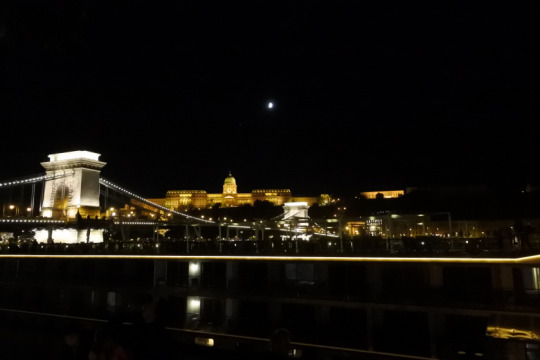
Accommodation
We stayed in Pest (the flat part of Budapest) and almost everything was walking distance from our place. Our Airbnb studio flat was near the main tourist high street, Danube bank and Vörösmarty tér (Square). It was so handy and there was no need to take public transport. I also enjoyed biking one day by the river – it was quicker way to explore the bank and also chill out. Streets are full of cyclists so definitely worth trying.
The city has plenty of Airbnb, hotels and hostels – so good choice for any type of travel. I’m fan of hostels and next time I go – I will try this option. Budapest is perfect for sightseeing, partying and meeting other travellers.
Cash or Card
I am not big fan of cash and normally prefer to pay with a card. Luckily, in Budapest in most places to eat and all thermal baths you can pay with card. Cash is required if you purchase a ticker for some attractions or at local markets. Be aware – sometimes it is not possible to split a bill if paying with card. Also, there are ATMs almost everywhere – at the airport, near major stations and banks.
Budapest – My favorite thing about the city is the sightseeing places and thermal baths. If I was living there, I would stop going to gym and focus on swimming in the baths instead. I enjoyed chill in the water on a hot day. Here’s what we did over the weekend…
Walking Tour & Sightseeing
If you visit the city, I strongly recommend trying out any of the free walking tours available. They are fun and at the same time you can learn more about the city and local history. This is the tour we attended:
Budapest Free Walking Tour
It starts every day at 10:30 am – meeting point is in the city centre, Vörösmarty square (at the lion fountain). It is free and at the end of the tour, you tip as per your budget. The tour covered some of the top sights in the city like – St.Stephen’s Basilica, Chain Bridge, Royal Palace and Fisherman Bastion. Our tour guide, A. was funny with great sense of humour and she told us more about the local history with some “politically incorrect” insights. This is what I like the most! It’s cool to hear that the Change Bridge is the biggest in Budapest or Vastagh Gyorgy and his horse’s statue (it is in Buda) is famous for the balls of the horse! Apparently, before exam local students come to the statue and touch the balls for good luck. Another interesting insight is from the communist times – after Hungary was “liberated” from the Nazis by the Soviets, “Soviets wanted to make sure that Hungary is Nazi free that they forgot to go home for the next 45 years”.
This slideshow requires JavaScript.
Also, you could learn several Hungarian words, which is fun as the language is nothing like any other language in Europe. Well, apart from Finnish and Estonian – apparently the 3 countries have common ancestors, who have split after arriving in Europe. In any case, I remember the essentials:
beer is shur
wine is por
Other cool place to visit in Budapest is the Liberty Statue – located on one of the hills in Buda and watching over the city. This is Soviet monument, and because it looks cool it was not destroyed after the collapse of communism. It’s popular spot for young people to have a drink at sunset, and enjoy the view of the city.
Not to miss is also the building of the Parliament – the working place of the Prime Minister of Hungary. It is the 3rd biggest Parliament in the world, and its architecture is absolutely beautiful! It stands at Danube’s bank and it’s a gorgeous view in the evening with all these lights.
I wanted to visit the National Museum as well, however I did not have enough time (got distracted in the baths!). As I heard, the museum has pretty interesting artefacts around local history and pagan / nomadic past of Magyars (Hungarian ancestors).
Not to miss is also the Catholic Cathedral, St. Istvan (or Steven) which has the sacred remains (piece of an arm) of the saint, who is the 1st official king of Hungary. The cathedral is beautoful and surely would be appreciated by art lovers.
This slideshow requires JavaScript.
Jewish district and the hipster Budapest
Obviously, the Jewish district is known for the history during WW2. It starts with the Great Synagogue at Dohany Street. It is the 2nd biggest synagogue (after the one in Amsterdam), though locals claim it is the biggest. It is an interesting monument and it is worth visit – just be aware of its opening hours and dress code. Also, in its garden there is a silver tree, whose leaves contain names of Hungarian Jews killed in WW2.
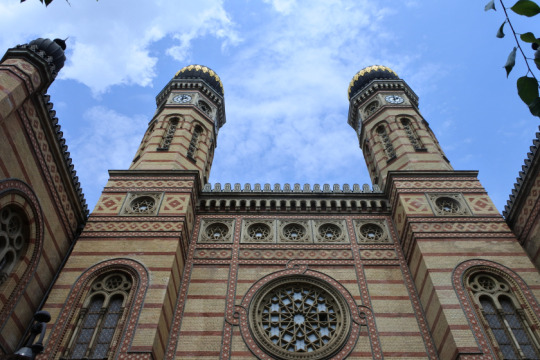
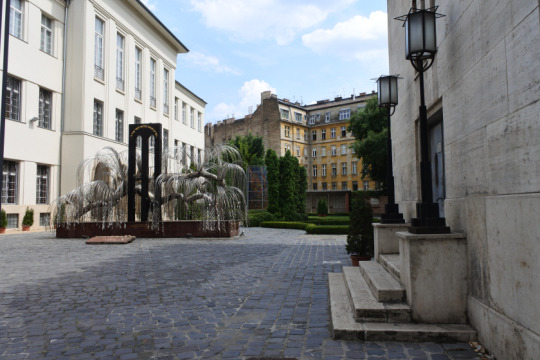
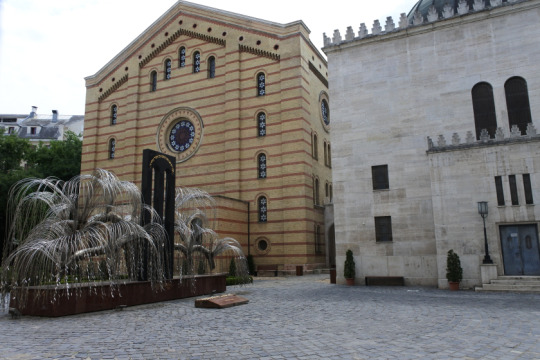
I’d say the district is my favourite part of the city – it is artsy, hip and young. It reminds me of London’s Shoreditch. I like the idea of using old stuff in a creative way and creating outdoorsy places, where people can socialise over a drink.
We visited very cool place – Szimpla – like a beer garden / bar open day and night. The definition of hipster place! Also, I bet it is great spot for live music in the evenings. No wonder is popular with tourists.

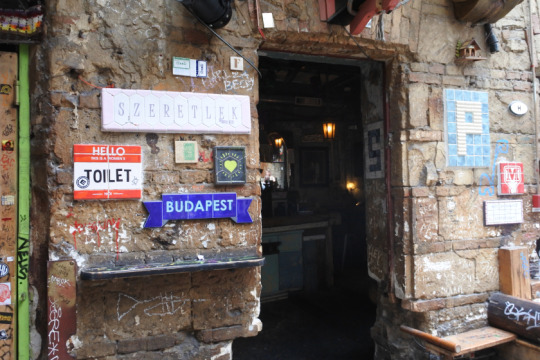
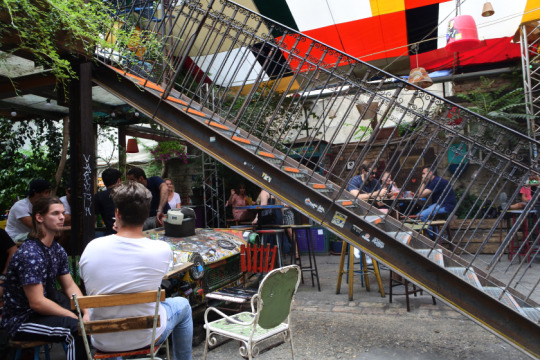
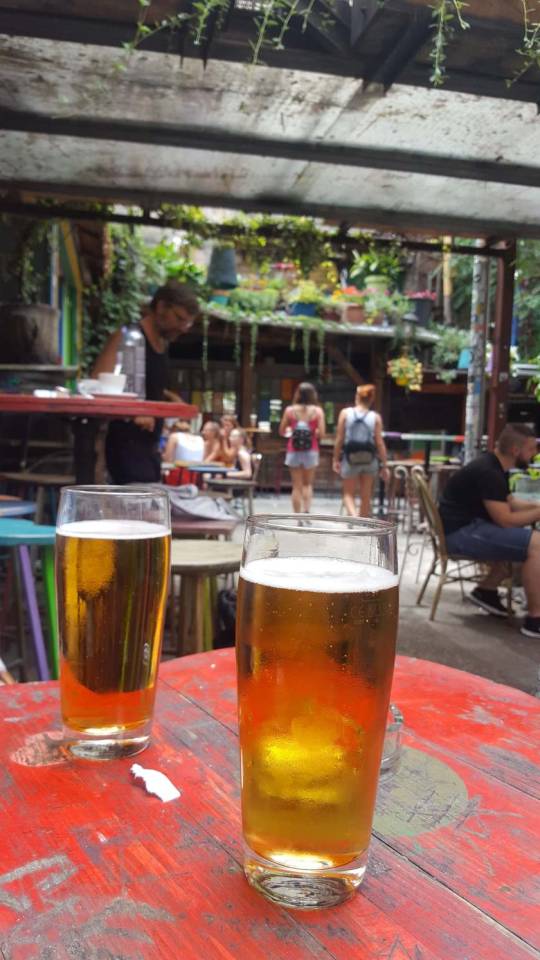
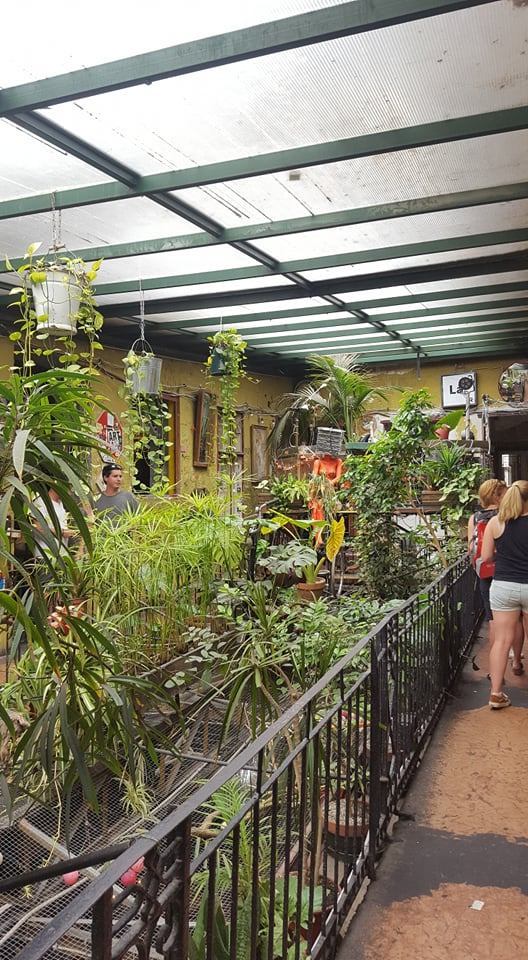

We enjoyed couple of Soproni pints (local beer) before moving on to the near by street food market Karavan. Here we tried the local “communist pizza” – Langos. You could also have touristy burgers and even vegan options are available. Karavan is a cool place, good to have local fast food and some beers.
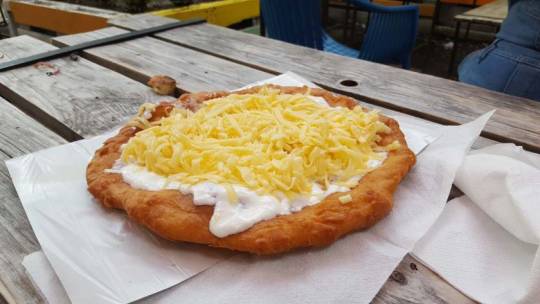
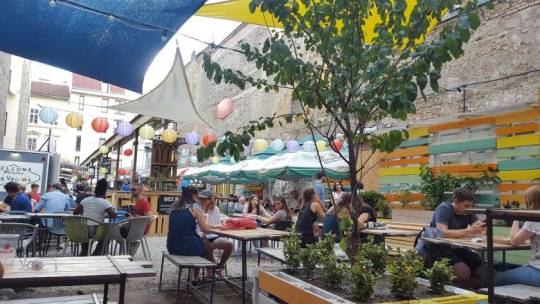

This area is also popular with the many bars, garden restaurants and night life.
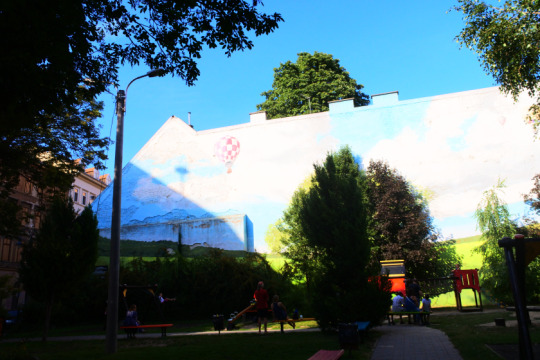
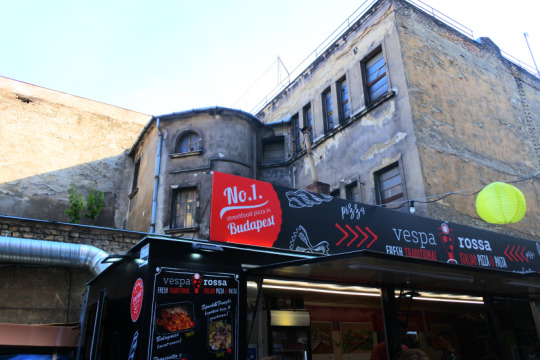
Thermal Baths
This is a must experience in Budapest! The city is known for its thermal baths and so I wanted to try at least 2 of them over my short stay. Baths are increasingly popular, and as I saw sometimes you have to queue to get in. I imagine this is annoying for locals because of queuing and higher prices. We visited 2 baths – Rudas and Szechenyi.
Night swim at Rudas Bath
Rudas is located on Danube bank, near the bridge. It has several sections – thermal baths, wellness and swimming pool. Entry is around 5100 F (or £15-£16). We tried out the night bathing from 22:00 to 04:00. It was busy Saturday night, and we queued for around 25 mins until we got it. The bath is well equipped with lockers, changing rooms, showers and laundry dryer.
The wellness part has 2 big pools with different temperatures – 26 C and 33 C (if I remembered correct). There are also 2 smaller pools – very cold and very hot 42 C. I tried to get in the hot one, and my feet was burning so I gave up on it. Some people manage to stay there for several minutes – admirable! I would feel like boiled chicken if I had to get it there! I was mostly in the bigger pools, which I thought are perfect place to have a nap whilst enjoying the jacuzzi effect. Really nice massage for your back or feet.
The thermal bath part on the other hand is located in an ex mosque. The mosque built in Ottoman times was regenerated and now its beautiful building is used as a bath. The night vibes are so relaxing – lights shadowing, beautiful ceiling and light blue watered pool. The bath here has 1 major pool (I assume it should be around 34 C).Once I felt hot, I was jumping in the other smaller pools – these are 4 more pools between 28 to 42 C. After hot pool, 28 feels freezing. Not to miss is the steam room too – how long could you stay in 50 C steam?
And the best bit of the bath is the rooftop! Smaller warm pool on the roof, with view towards Buda and Danube. It was beautiful! Imagine chilling there with a drink in the pool? A dream, and I quite enjoyed it. That night was even more beautiful as it was thundering and we could see the lightening in the sky from the pool. I am not sure how safe this is, but experience is worth it.
Szechenyi Bath
This bath is different – it is actually outdoors and is located outside the city centre, next to the zoo. The best way to get there is by Metro for several stops. Again, the bath is in a beautiful yellow building. It needs some renovation, however it still looks great. It has a swimming deep pool and 2 more big warmer pools. I spent my bday day there – sunbathing and chilling in all pools, trying out the bubbles and jacuzzi. Perfect place to float. Entry is again around 5400 F. There is also restaurant when you get hungry / thirsty.
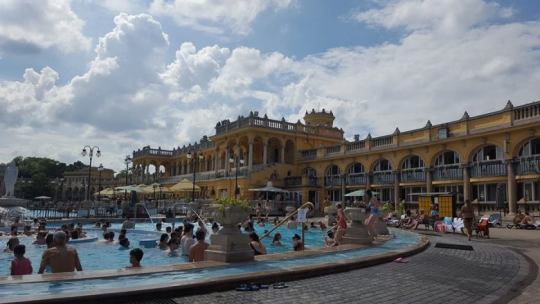
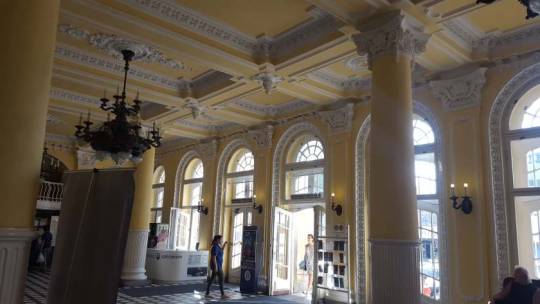
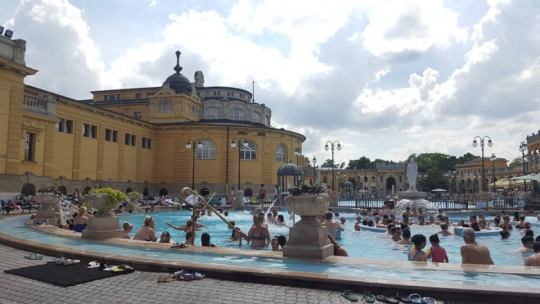
Speaking of food and drink…
Places to eat and drink
One flag here – Budapest city centre is full of Italian places. I love Italian food, however I would not eat it when in Hungary. To me – this is a tourist trap, and may suit well if you fancy pizza and burger (oh yeah, burgers everywhere). I am a fan of trying local dishes, so we were looking for places to have more Hungarian meals. Of course, in tourist areas prices are 3-4 times higher than the normal for locals. We were advised to eat in Pest, as Buda is more expensive and food is not greater.
So first – what is actually Hungarian food? Meat. Loads of meat. If you are vegetarian, or worse – vegan, you will struggle and you will not try locals meals.
Hungarian dishes
Goulash (Gulyás) – this is a soup with beef and paprika. The traditional version is soup, however tourists tend to have the stew version (which is the touristy option).

Paprikash – this is a stew with chicken, sour cream and paprika sauce, and also Hungarian version of dumplings. It is very tasty and goes well with red wine for dinner! Actually we have Paprikash in Bulgaria too, but ours is more tomato focused and no dumplings.
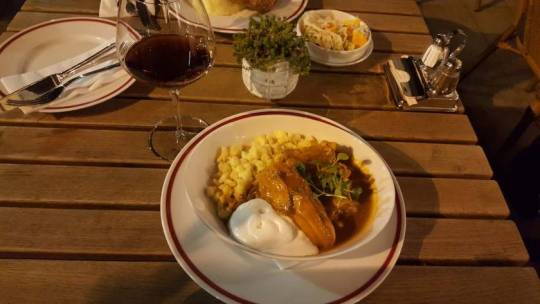
Langos – this is very popular street food. It is actually what Hungarian eat when drinking. It is fried fatty bread topped with sour cream and cheese. Other versions include paprika. I even saw Nutella Langos. It is very similar to our mekica – which we eat for breakfast.
Cake – Budapest has a plenty of bakeries or coffe houses and you can get delicious cakes. The traditional cake is a type of Sponge cake.
Hungarian drinks
Alcoholic on top of that.
Wine – Hungary is a wine region, so when visiting definitely try some loal wine. Red wines are particulartly good.
Palinka – Hungarian spirit, they say up to 70% alcohol. It tastes like fire. If you tried other Eastern European spirits like rakia you know what to expect 😀
Unicum – is a traditional herbal liqaur and they say is good to have a shot when getting a cold.
Where to eat?
Depends on your taste. We tried mixture of street places and nice restaurants.
Street food places – we tried Karavan market and the Central Hall Market. The Central Market has a range of grocery stands, souvenirs and up stairs it has several street food and Cafes. I got a chocolate truffle cake for 300 F and it was the best cake I had in town.
For breakfast, we tried to very good places: Kuglof and a French bakery Amber. At Kuglof I really liked the French toast with fried eggs and Paprika, and the massive chocolate latte. At Amber I gave a try to another chocolate cake.



For dinner, I enjoyed soup guyash at Hungarian bistro. I also tried chicken paprikash at another garden restaurant Borze Kavehaz, which was pretty good. Portions here are quite big, so I was struggling to finish my meal.
Budapest is one of my favourite cities, and I will be back. I have always wanted to visit around NYE – as it’s beautiful and why not anjoy thermal bath again when cold?
Definitely great place for weekend trip and / or solo travel!
Weekend break in Budapest -this is why it’s a good idea!
This year my friend and I have picked Budapest as the place to celebrate our birthdays. Great way to try something different and be away from London for couple of days.
Weekend break in Budapest -this is why it’s a good idea! This year my friend and I have picked Budapest as the place to celebrate our birthdays. Great way to try something different and be away from London for couple of days.
#budapest#culture#danube#europe#food#hungary#paprika#thermalbath#tips#travel#walkingtour#weekendbreak
0 notes
Text
Healthy Body, Healthy Heart
It takes a lot to shock me, but I can’t deny I was literally taken aback yesterday to read that in a recent survey (conducted by Damart and Heart Research UK), 90% of women do not reach the recommended level of exercise each week. So only 1 in 10 females here in the UK are moving their body for the recommended 30 minutes per day, every day. I was shocked and to be honest saddened at this cold, hard truth – even more so when I read on to see than 8 out of 10 cases of coronary heart disease are preventable by avoiding smoking, an unhealthy diet, and a lack of daily exercise. In an age where exercise options have never been greater, nor healthy food more widely available, how can this have happened? In an effort to try to inspire women to get more active and help to change this shocking statistic, here are my top tips for females everywhere to boost not only their overall health, but specifically their heart health.
Photography by Anna Rachel.
These boots were made for walking
Or trainers, or ballet flats, or even flip flops if you prefer! Doesn’t matter what you’ve got on your feet – just use them. Walking is free and can be done literally anywhere and any time. It is one of the most under-rated forms of exercise which is such a shame when it burns calories, improves cardiovascular endurance and is accessible for everyone thanks to being low-impact. If finding 30 minutes a day to get on your feet is tough, then try to think of ways you can incorporate it into your daily routine. Do you drive to work? Why not park 15 minutes away from your office? That way you’ve got a 15 minute walk to and from your car every day. Have to drop your kids at school in the morning? Why not walk together rather than getting the bus? Or if the morning routine is tight, why not head to the park after school together and walk a few laps on the way home? If you get public transport to work, think about getting off a few stops earlier on the bus or tube and walking the rest of the way. And if you are on the tube or taking the train then forget escalators and lifts – take the stairs and use your feet! A lunchtime walk is a great idea if your job means you’re seated for much of the day. A half an hour stroll outside will get you away from your desk, allow you to be more mindful as you take in your surroundings, and energise you for the afternoon of work ahead. If your evenings are packed with social catch ups, consider making some of them on foot – you can still hear all about your friends new man or moan to them about what a slave driver your boss is as you walk and talk together. Why not get some matching T-Shirts printed so you even feel like a little team? Bulk t-shirt printing could be the answer!
Get fit in the comfort of your own home
Yes it’s true – in this digital age you can work out with some of the worlds’ best trainers…. without even stepping outside your front door. YouTube, Instagram and Facebook Live mean it is easier than ever to get access to literally thousands of different workouts from our laptops and phone screens (check out some of mine here) – so you don’t even need a gym membership or access to a swanky boutique studio to try out some of the latest fitness trends. From yoga to HIIT to boxing to Beyonce Booty Shaking – there’s an online workout video out there to suit you – start searching through YouTube to discover some channels and presenters with content that you like, and make your own YouTube playlist adding all your favourite workouts and classes – then you have your own workout library ready to go, without having to go anywhere!
Try Try Trial Again
So you don’t have the room to workout at home, or you’d just rather your flatmates didn’t hear you doing burpee after burpee on your bedroom floor? There are still plenty of places you can go and train, and the vast majority of gyms and studios will offer you a free trial class or period for you to check out their facilities and see if they work for you. So you can still get access to some of the best gyms and classes in your area, without the upfront financial commitment. Some studios will offer the first class for free, or a bundle or 2 or 3 classes for a special introductory price, so you can shop around, find out what works for you and get fit at the same time. Or why not check out your local leisure centre? Many are lucky to have had huge council investment meaning they have excellent facilities and a range of classes – but without the boutique studio price tag. They also usually offer a pay as you go option, so if you fancy Body Pump one day and a game of badminton with your boyfriend the next then your local leisure centre will offer that flexibility.
It Ain’t What You Do
To most people, when they think of exercise or physical activity, images of 5am bootcamps in the mud, gruelling 10k runs, or spinning classes where you end up drenched in sweat and unable to stand up after dismounting the bike tend to come to mind – but being active doesn’t have to mean pushing yourself until you need to vomit into the bin. Hitting the target of 30 minutes of physical activity every day could be done in a pilates class, swimming, playing tennis, salsa dancing, riding your bike…. and in hundreds of other ways. Of course in order to see improvements in fitness, strength and stamina you need to start to push yourself and your body – but for many this seems such a long way off, which is why it is important to realise that you don’t have to push yourself to the point of collapse for it to count towards your daily activity. In fact going from doing nothing to high intensity training is risky – and even gold medal winning athletes had to start somewhere. Moving your body is moving your body – so do it in a way that works for you – and that way you’ll be more likely to stick to it.
Goal Getter
In order to maintain motivation, it can be really helpful to have something to work towards. When it comes to fitness, often goals tend to be weight related, but I think the best goals are more about physical achievements – e.g. hitting 10k steps every day, being able to run your first 5k, performing full push ups etc. Why not set yourself a target to work towards so that your training has a focus? It is easier to track progress which in turn can help to keep you motivated, not to mention the satisfaction when you hit your target – and all whilst getting active for the recommended 30 minutes every day.
I truly hope that this tips will help to inspire you to get more active, and to help incorporate activity into your daily routine, not least because heart disease can affect anyone at any age, but they sadly women are more likely to develop heart disease than men. Heart disease CAN be prevented, and Heart Research UK advise that healthy eating and an active lifestyle are two of the best ways to do this. We may live in a world obsessed with statistics (number of Instagram followers, what celebrities earn, the number on the scale) but I truly hope that with simple changes in lifestyle that we can help reduce the 90% of women who currently don’t reach the recommended activity level. If you know someone struggling to hit their target, please share these tips with them, and get behind them to encourage them to get moving. It may just save their life.
The post Healthy Body, Healthy Heart appeared first on Wildcat Fitness.
from Healthy Body, Healthy Heart
0 notes
Text
A Digital Nomad Guide To Living in Medellin, Colombia
Digital nomads are always looking for somewhere to work with good wi-fi and a decent cup of coffee. I personally try to find a destination with at least one other nomad around, where the concept of sitting in a cafe for hours on my laptop isn’t too strange. But in Medellin, it’s not a question of ‘where can I find the best cafe’. The question really is – ‘which one should I choose?’
As Colombia’s second biggest city, which was recently named “the world’s most innovative city”, it’s no surprise that it has become such a major hub for digital nomads.
If you’re considering living in Medellin, Colombia, here’s all you need to know.
READ MORE: Travelling to Medellin, Colombia: Our First Impressions and Experiences
Best Areas to Live in Medellin & Rough Costs
The most popular places for digital nomads to live are south and west of the city centre: El Poblado, Envigado, Ciudad del Rio, Laureles, Floresta, Estadio.
El Poblado: Tends to be the most expensive area as it’s the most touristy. A double room in a shared apartment will start around 1m COP (roughly 330 USD) per month. A one bed apartment starts around 700 USD per month.
Envigado: Technically located outside of Medellin, Envigado is a little further south than El Poblado. Prices are similar – sometimes a little less. If you are looking for somewhere close to Poblado but not within the tourist bubble, it could be a good option.
Ciudad del Rio: Close to El Poblado but accommodation is usually a bit cheaper here, as it’s less touristy with lots of apartment blocks. Prices for a standard room in a shared apartment start around 600k COP (roughly 200 USD). A one bed apartment usually starts around 600 USD per month.
Laureles/Estadio/Floresta: These areas are located west in Medellin, and feel a little more authentic Colombian than El Poblado (although they are westernising quickly). They are close to the football stadium, a public sports arena, and home to one of the main universities – so it feels young and vibrant, full of Colombian students that live here. A double room in a shared apartment should start around $600k COP (roughly 200 USD). For a private one bed apartment, expect to pay from 500 USD per month.
If you are looking to live in luxury with amazing panoramic views of the city, there are a lot of penthouse apartments (with pools, gyms, saunas etc) dotted around all these areas – for a fraction of European prices.
Where to Search for Apartments in Medellin:
Comparto Apto: Often the best place for value as you deal directly with the landlord, on this website. However, you will most likely need to have a basic level of Spanish to be able to communicate with the landlords.
Facebook groups: Sometimes the costs can be marked up a little, but it’s relatively easy to find a room especially for English speakers. Check out “Digital Nomads Medellin” and “Medellin Rooms, Apartments and Expat Info”.
Airbnb: Lots of rooms are available here, and many have discounts on stays over a month.
Best wi-fi Spots & Cafes to Work In
Internet connection is generally very strong around the city, and there’s frequently free wi-fi in the streets and parks. (But as with any public network, be careful using it for anything personal)
My favourite cafes & spots to work in are below:
El Poblado
Botanika Lounge – great wifi connection with plug sockets under every table
Cafe Zeppelin – go for the menu of the day for 12,000 COP (under 4 USD) and stay all afternoon
Pergamino – known for the best coffee in El Poblado
Cafe Velvet – a popular spot for nomads although you need to get there early as plugs are a little sparse
Amarillo Chocolate – cute interior with a great selection of veggie sandwiches
Como pez en el agua – go for brunch and stay all day (their fried eggs on toast with mushrooms & truffle oil is just 16,500 COP – approx 5.50 USD)
Envigado
Cafe Otra Parte – great garden and terrace if you want some peace and quiet from the hustle and bustle of Poblado
Cocolatte – relaxed atmosphere, great coffee and friendly staff makes it easy to stay all afternoon
Ciudad del Rio
Cariñito Cafe – often a bit quieter than the Poblado cafes, with an impressive coffee menu & large terrace
Laureles
Algarabia – has a scenic view overlooking the second park in Laureles
Cafe Revolucion – located on the main road, it can be a bit busy but it’s great for people watching at the same time.
Naturalia Cafe – one for the health conscious foodies out there, with an extensive menu & another cheap but great menu of the day
Floresta
Hostal Ondas – has a cafe on the ground floor open to anyone, and a great co-working area above
Transport Options in Medellin
Getting around the city is generally very easy and cheap – either by taxi, metro or bus.
Local taxis: There are plenty of taxis driving round the city; however, sometimes it can be tricky to track them down. Often they don’t stop, despite seemingly looking empty.
Uber: The rules on Uber are slightly strange in Medellin. Technically it is illegal to take an Uber, but the app still exists – so it is very easy to pick them up. However, if the police stop you, you could be in trouble. Therefore, I’d recommend taking the local taxis – they are similar in price anyway.
Metro: The standard cost of the metro is 2,300 COP (roughly 80 cents), for pretty much all trips (regardless of the distance). It was built to enable locals up in the outskirts work in the centre – so it’s a great option to save money. Unfortunately the metro station in Poblado is a little way out of the centre, at the bottom of a hill – so if you take the metro to go to the centre of Poblado, be prepared to walk up Calle 10.
Bus: There are lots of buses around the city so you can easily pick one up from the side of the road. There aren’t as many bus stops but they stop and pick you up as it drives along the route on the main road. They say in big letters on the front where they are heading – but always check with the driver when you hop on, and if in doubt, ask the guy next to you. Each journey costs between 1,900 COP (under 1 USD).
The metrocable in Medellin
Nomad Community
With the massive influx of nomads, there are lots of meet-ups and social events. Hostel Ondas has a weekly social on their roof, specifically for digital nomads, and there are lots of independently organised Couchsurfing meet-ups. Plus, there are lots of groups on Facebook, which you can request to join and be part of the community. For example:
Digital Nomads Medellin
Medellin Digital Nomads
Start-up Medellin Digital Nomads Network
Medellin Entrepreneurs Society
So if you are looking to make some friends with like-minded people, it shouldn’t be too difficult.
Living Like a Local in Medellin
Groceries
The most popular supermarkets are: Exito, Jumbo, Euro, & Carulla. There are many large supermarkets, as well as smaller convenient stores, all over. Exito, Jumbo & Euro are cheaper; Carulla is more premium.
For the more niche health foods, there are shops such as Salud Pan or Ceres Mercado Organic where you can pick up non-dairy milks, nut butters etc.
Plaza Minorista is a huge market with lots of fresh fruit, veg, meats, cheeses and more (e.g. the superstitious soaps that apparently the locals like to buy, to get good fortune in things such as love or finances). Goods here are cheaper than in the supermarkets, but its location in El Centro means it’s not as convenient to just pop down there, if you are coming from one of the resident areas mentioned above.
Street food
Arepas & empanadas are everywhere! There is a wide variety of types and flavours of each, and prices usually start at 2,000 COP (0.65 USD).
Drinks
Beer
The two most common, and generally cheapest, beers are Aguila & Club Colombia. Expect to pay around the following:
Supermarket: 2,000 COP (0.65 USD)
Local pub: 4,000 COP (1.30 USD)
Bars/restaurants: 6,000 COP (1.95 USD)
Nightclubs: 8,000 COP (2.60 USD)
Spirits
Aguardiente is the national spirit that’s available all over Colombia. A 750ml bottle costs around 27,000 COP (just under 9 USD) in the shops, and with an aniseed taste, similar to sambuca, it is popular with the locals. (It’s not for everyone though!)
“Ron Medellin” is Medellin’s most popular rum, and is the cheapest spirit, after aguardiente. A 750ml bottle is around 28,000 COP (just over 9 USD) in the shops.
Juices
Colombians love their juices, and there is usually a juice of the day included within the menu of the day at lunch. Popular flavours are:
Lulo – an exotic, sour Colombian fruit
Maracuya – passionfruit
Guanabana – a unique Colombian fruit, that almost tastes both sweet and sour.
They usually cost around 6,000 COP (1.95 USD).
Water
Tap water in Medellin is fine to drink. However, if you do travel elsewhere in Colombia, check the health warnings as it’s generally not drinkable in most other areas.
Exercise
They say the Colombians are some of the most beautiful people in the world – so if you are looking to join the crew and stay in shape, there are plenty of places to go in Medellin.
Gyms
Alpha Fitness (Poblado) – has a great timetable for classes such as HIIT, TRX, yoga and crosstraining
Bodytech (all over) – loads of equipment available but one of the more expensive gyms, although you can get a trial pass which has 3 days free
Dinamo fitness (Envigado) – tends to be a bit cheaper, especially if you choose an off-peak membership
Yoga
Flying Tree (Laureles) – classes are available in both English & Spanish; 1x class is 25,000 COP (8.20 USD) or monthly unlimited passes are 160,000 COP (52.50 USD).
Running / walking
Parque Arvi – take the gondola to this massive area of nature, where you can walk around & enjoy the waterfalls and more
Cerro El Volador – a short but very steep hill close to Estadio, with incredible views overlooking the whole city
Stadium (Estadio) – the full-sized athletic track is free for public use
Nightlife
There’s a variety of bars and clubs all over the city, although they are most heavily saturated in El Poblado or Laureles. Reggaeton and salsa are probably the two most popular music types for the locals, but there are numerous places around so you’ll find something to suit your taste.
El Poblado:
The bars and clubs here tend to be a bit more western with more techno, house as well as the more Colombian reggaeton, salsa and bachata.
Electronic music: Mansion & Calle 9 are two popular clubs at the weekends, with entry usually costing just 10,000 COP (3.30 USD). Salon Amador has a good sound system but is a bit swankier and more expensive (usually 35,000 COP, approx 11.50 USD – although it can be more on special nights)
Salsa: Mojito Salsa Guaracha y Son. is a small, intimate but popular one.
Cheap beers with a chilled atmosphere: Latineria – located on Parque Poblado – has beers for around 4,000 COP (1.30 USD).
Laureles:
Calle 33 and the ‘setente’ (Carrera 70) is where most of the bars are situated here. They tend to feel a little more local, with more salsa and reggaeton.
Salsa/bachata: Son Havanah & El Tibiri are both popular spots amongst the locals
Carlos E Restrepo (not in, but close to, Laureles): A super eclectic area, close to the university, where many locals hang out and drink beers on the street, singing and dancing to the street performers. Drinking in the streets was banned in January, so this is one of the few places where you can chill at night.
Can’t speak Spanish?
Medellin is a very cosmopolitan city so most people in cafes and shops speak English – especially in the more western areas of Poblado & Laureles. El Centro is slightly less Western so you may find it a little harder to communicate in English but on the whole, you shouldn’t struggle too much without any Spanish.
There are lots of Spanish schools around and language exchanges if you do want to pick it up while living there. Some recommended Spanish schools are below:
El Poblado
Toucan
Laureles
Prime
Colombia Immersion
Weather in Medellin
Medellin is also called ‘The City of Eternal Spring’, because the weather is generally pretty good all year round. It does rain from time to time (and usually when it rains, it pours) but it’s consistently warm, being in the high 80s F / low 20s C.
It’s a cultural hub
There are many museums, independent theatres and cinemas, concerts and street art to inspire you when you’re not working. Botero’s sculptures are dotted around the city, there’s a plaza filled with 20m tall lights (Parque De Las Luces), and Comuna 13 (home to hip hop & graffiti artists) has some of the most vibrant street art in the city.
The list is constantly growing so it would be difficult to exhaust everything – but in the unlikely event of that happening, Medellin has two airports and national bus stations, so it’s easy to travel internally for a weekend away.
Safety in Medellin
One of the main things which puts people off visiting Medellin is the question of safety. The city has undergone a massive transformation in the last 20 years, and the locals are trying super hard to shift the stigma to increase tourism.
There are the same general precautions which need to be taken, as with any big city. However, from a personal perspective, I can honestly say that I haven’t felt at risk at all. Obviously, if you go looking for the illegal stuff, you will put yourself more at risk – but if you are careful, it shouldn’t be any more dangerous than any other big city in the world.
With a low-cost of living, good internet connection, and a large nomad community – it’s no wonder more and more nomads are flocking here. Will you be next?
Looking For More Medellin Posts?
10 Cool Things To Do in Medellín, Colombia
Backpacking Medellín, Colombia: A Beginner’s Guide
Canadians in Colombia: Experiencing a Football Game in Medellín
Why You Shouldn’t Miss The Medellín Walking Tour
The post A Digital Nomad Guide To Living in Medellin, Colombia appeared first on Goats On The Road.
via Travel Blogs http://ift.tt/2vE7jos
1 note
·
View note
Text
21 Things To Do in Playa del Carmen, Mexico
There are so many incredible things to do in Playa del Carmen that it can be hard to sort through the options.
Well, I’m here to help. After three months living here, I’ve had plenty of time to try out many of the awesome activities in Playa del Carmen: and I’ve come up with this list of the 21 absolute best things to do in Playa del Carmen in order to help you make the most of your trip to this beautiful town on Mexico’s Mayan Riviera.
From the secret beach spots, to where to find unique local dishes, to the best day trips, I’ve got you covered with an exciting array of things to see in Playa del Carmen. This is one of the best places to visit in Mexico for sure.
Oh, and you’re definitely going to want to try #17 – some people love it and some hate it, but you’ve got to check it out yourself to find out! (also, don’t miss the traveller’s resources at the end of this article). But first…
Getting From Cancun Airport to Playa Del Carmen
You have different options to get from the Cancun Airport to Playa del Carmen — either take the bus, rent a car, take a taxi, or hop in private transportation booked prior to arrival.
The fastest, safest and most comfortable option is to take private transportation to Playa del Carmen. Don’t waste your precious holiday time waiting for buses and getting ripped off by cabs. Check out Cancun Airport Transportation, which offers a variety of vehicle options — for solo travellers, couples and groups.
Here are my top picks for fun things to do in Playa Del Carmen!
1. Take a Dip in a Cenote (one of the most refreshing things to do in Playa del Carmen)
Believe it or not, the best places to swim in Playa del Carmen aren’t in the ocean. Ask any local where to take a dip and you’re certain to get the same answer: visit a cenote.
What’s a cenote?
Well, I’m glad you asked. Cenotes are essentially underground swimming holes formed where limestone bedrock gives way to underground rivers and springs. There are thousands of them in the Yucatan peninsula and visiting one should be at the top of any list of things to do in Playa del Carmen.
There are many cenotes to choose from, but my personal favourite is Cenote Azul. You can visit on your own by taking the “collectivos” that leave for Tulum on Calle 2, you can rent a car to get there (just be sure you have travel insurance covering Mexico), or you can join up as part of a tour. Oh, and if you’re certified, you can even go diving in many of the cenotes!
☞ SEE ALSO: Submerging Into Centoes – A Cave Dive in Mexico
2. Explore Chichen Itza
Named one of the New Seven Wonders of the World, the Mayan ruins at Chichen Itza are a spectacular site to behold.
One of the most important archaeological sites in all of Mexico, Chichen Itza is located deep in the jungle, and a bit of a challenge to reach. You can rent a car and make the two-hour drive yourself, or check out any of the many tours from Playa del Carmen to Chichen Itza.
Pro tip: if you can, get up early and visit the temples before the crowds and the heat set in.
Click here to learn more about the Chichen Itza tour from Playa del Carmen.
3. Try Traditional Mayan Food (and Grasshoppers) at La Perla Pixan Cuisine
Finding authentic local cuisine in Playa del Carmen can be a bit of a challenge, as the tourist zone is filled with imported restaurant chains started by celebrity chefs.
But nestled in the hustle and bustle of La Quinta Avenida (Playa’s main pedestrian drag) is La Perla, a gem of a restaurant that serves up traditional and utterly delicious Mayan food with nightly performances of live music.
Try the traditional tlayuda or, if you’re feeling really adventurous, any of the several dishes made with grasshoppers! Eating authentic Mexican food is one of the best things to do in Playa del Carmen, and Mexico as a whole.
☞ SEE ALSO: Things To Do in Cabo San Lucas – A List of The Top 21
4. Chill Out at Lido’s Beach Club
For a place whose first name literally means “beach,” it can be surprisingly difficult to find a comfortable and affordable stretch of sand. Most of Playa del Carmen’s prime beachfront is consumed by exclusive resorts or beach clubs charging exorbitant prices for the use of a beach chair.
Thank goodness, then, for Lido’s beach club, where there’s no fee for using the beach loungers and no minimum spend. Just pay for whatever you order, and enjoy the comfy green loungers or the swings at the laid-back bar.
For the best neighbourhoods and accommodation options, check out our guide to where to stay in Playa del Carmen.
5. Swim in the Rooftop Pool at Be Playa
One of the most relaxing things to do in Playa del Carmen is to hang out at one of the city’s many rooftop pools. My favorite of the bunch is the pool that sits atop the stylish Be Playa hotel.
You’ll need to spend a minimum of 200 pesos ($9.60) per person to enjoy the pool, but it’s well worth it and that total is still only half the minimum spend at most other rooftop pools in the area. The drinks here are solid and the pool is rarely overcrowded. It’s a great way to beat the heat year-round.
6. Wait in Line at El Fogon
I know what you’re thinking: why in the world would waiting in line be on a list of the best things to do in Playa del Carmen?
Well, try the food at El Fogon first and then we’ll see if you’re still asking that question.
Easily the most popular restaurant in Playa del Carmen, El Fogon is a Mexican cantina so busy that its main location on Avenue Constituyentes sports a sizeable line every night starting around 7:30 PM. Don’t worry though, the line moves fast, and the wait is well worth it (just ask the many locals who frequent the joint).
7. Take a Day Trip to Xpu Ha
There are many incredible beaches just a short ride away from Playa del Carmen Mexico, but my favorite is the secluded beach at Xpu Ha. You’ll need to either rent a car or take a collectivo minibus to get there, but the journey will reward you with access to a pristine white sand beach with clear water and without the crowds.
There is a 50 pesos ($2.40) entrance fee to the beach. You can get that back if you meet the minimum spend at one of the handful of beach clubs, or you can just bring your own towel and settle in on any of the many wide open stretches of sand.
☞ SEE ALSO: Things To Do in La Paz – A List of The Top 21
8. Dine in a Cave at Alux Restaurant
Right off one of the busiest and most chaotic streets in Playa del Carmen is the understated entrance to the Alux restaurant.
You’ll feel like you’ve left the city behind as you descend into the spectacular underground cavern (complete with its own mini-cenote) that plays host to the restaurant. If you’re looking to splash out, Alux also offers some of the best fine dining in town with main courses starting at 350 pesos ($16.75).
9. Check Out the Frida Kahlo Museum
One of the most popular things to do in Playa del Carmen is to visit the stylish Frida Kahlo Museum. Conveniently located on La Quinta, the museum is open everyday from 9 am to 11 pm and the entrance fee for the general public is around $15 USD.
Inside you’ll find a series of exhibits dedicated to the life and history of Mexico’s famous portrait artist (note that, unfortunately, there usually aren’t original works on display).
10. Try Some Elote
Elote is a local street food dish that is essentially grilled corn covered in a sort of mayonnaise and cayenne pepper paste.
Ok, I realize that doesn’t sound super appetizing but trust me… it is.
You can find elote at street vendor stalls around town for juts a dollar or so: the best bet for finding it is on Avenida Juarez around the intersection with Calle 15.
11. Go Salsa Dancing at Zenzi
One of the most fun things to do in Playa del Carmen at night is to get your groove on. And there’s no better place to do that than Zenzi, an upbeat but not-too crowded joint with live music and a vibrant dance floor. Thursdays and Saturdays are usually salsa nights, but check the schedule on to be sure.
Have two left feet? That’s fine, you’ll still love the fun ambiance, affordable prices, and the incredible beachside location.
12. Explore the Caverns at Rio Secreto
Have you ever been swimming inside a cave before?
Well, if not, you definitely need to check out this unique thing to do in Playa del Carmen.
Located just a few minutes outside the city, Rio Secreto is a complex of five stunning caves that are filled with underground rivers and springs. You’ll don a wetsuit and join a small guided tour through a cave that includes the incredible experience of swimming inside a pitch black cave. It’s definitely one of the awesome things to do in Playa del Carmen.
Goats On The Road visited Rio Secreto a few years ago and we still think about how incredible the experience was! The cave truly is stunning and swimming through it is something we’ll never forget. This is definitely one of the things to do in Playa del Carmen that you won’t want to miss. Click here to book your entrance tickets including transportation, and click here for just the entrance ticket.
☞ SEE ALSO: Rio Secreto – Cave Exploration in the Riviera Maya
13. Ride a Jet Ski
At at least $50 per hour, it’s not a cheap activity in Playa del Carmen, but renting a jet ski is definitely an exciting way to enjoy the water in and around Playa del Carmen.
You can find vendors renting jet skis along La Quinta Avenida, or book a package tour including jet skis in advance.
14. Stroll the Shops of La Quinta
The main artery of Playa del Carmen is La Quinta (5th Street), is a vibrant pedestrian street running well over a kilometer parallel to the beach. La Quinta is lined with hundreds of shops and vendors offering everything from designer handbags and questionable pharmaceuticals, to funky trinkets and unique artwork.
Sure, it’s more than a little touristy, but a visit to La Quinta should be on every list of things to do in Playa del Carmen.
Looking for more Mexico posts? See Also:
Things To Do in San Pancho – A List of The Top 15
Things To Do in Puerto Vallarta – A List of The Top 20
Things To Do in Guanajuato – A List of The Top 10
Places To Visit in Mexico – Top 12 Spots
Backpacking Mexico – Top Reasons To Travel Here Now
Manzanillo Colima – The Ultimate Travel Guide
15. Go Paddleboarding at Fusion
The Caribbean water in Playa del Carmen is blissfully still, especially right before sunset, which makes it a great place to try out paddleboarding.
Paddleboarding rentals or lessons can be arranged through Aloha Paddle Club, starting at around $45 USD. The location is at the Fusion beach bar, which also makes a great stop for a drink or three after you’ve come back off the water from this awesome activity in Playa del Carmen.
16. Party the Night Away at Coco Bongo
Ok, so it may be a little cliché, but there’s no denying that Coco Bongo is the mainstay of Playa del Carmen’s throbbing nightlife scene.
At over $80 U.S. dollars for a ticket, a night at Coco Bongo doesn’t come cheap. But your admission includes drinks, a spectacular show featuring rotating acts (this past May saw a Star Wars-themed show), and a night you won’t easily forget (or maybe you will….). Partying at Coco Bongo is one of the most popular things to do in Cancun as well.
17. Try a Marquesita
A marquesita is a local dessert that sort of resembles a crunchy hand-held crepe. The traditional version is served with Nutella and Edam cheese, which makes for quite the unique flavour combination, though you can also get them with peanut butter, cream cheese, chocolate syrup, or a variety of other toppings.
Marquesita are served up by mobile street food vendors, so you may need to keep your eyes open to find one. The best places to look for them are on Calle 2 and Avenida Juarez around their intersections with Avenida 20.
18. Escape the Crowds at Punta Esmerelda
Playa del Carmen’s main beaches get crowded quickly, so do like the locals do and head north to the much quieter, much less commercial beaches at Punta Esmerelda. It’s one of my personal favorite places in Playa del Carmen.
You won’t find huge beach clubs here, but you will find a small cenote and some of the best beaches in Playa del Carmen. You can get to Punta Esmerelda by taking a short taxi ride from town, or by walking north along the beach for 45-60 minutes from central Playa.
19. Visit Parque Fundadores
Playa del Carmen doesn’t have many traditional points of interest (the city is largely built around tourism), but one the more interesting places in Playa del Carmen that you can find is in Parque Fundadores.
There, you’ll find the Portal Maya Statue, a gorgeous sculpture depicting two figures rising up to touch each other. You’ll also street vendors selling snacks and wares, as well as the occasional public performance by dancers.
20. Swim With Sea Turtles
Just a short ride south of Playa del Carmen lies the quiet beach outpost of Akumal, one of the best places on the planet to go swimming with sea turtles.
You can access Akumal as part of the many guided tours that offer snorkeling here, or you can take a collectivo south from Playa del Carmen, walk to the beach, and rent your own gear. You don’t even need a boat to swim with the turtles – you can usually find several just a short distance off the shore.
21. Take a Ferry to Cozumel
Hop on a ferry from Playa del Carmen’s main dock and in 45 minutes, and 135 pesos later, you’ll find yourself whisked away to the island of Cozumel, home to some of the bluest water in this part of Mexico.
Once in Cozumel, you can enjoy the world-class diving and snorkelling scene. Or you can rent a car (my favourite: the old VW convertible beetles!) and take a drive around the island, stopping at the many beach clubs that dot the route.
Ready for Playa del Carmen?
There’s so much to do in Playa del Carmen that you might feel overwhelmed with all these amazing options, but the truth is that you can’t go wrong with any of the items on this list.
I’ll leave you with a quick tip to help you save some cash during your stay in Playa del Carmen: while many vendors accept US dollars and the ATM on La Quinta even dispense them, the exchange rate you’ll get is likely to be a huge rip off. So pay with pesos and use the money you’ll save to do a few more things in Playa del Carmen.
Playa del Carmen: Resources & Recommendations
Travel Insurance
WE RECOMMEND WORLD NOMADS
There are a lot of adventure activities in this city! Make sure you're protected with a good travel insurance policy. We use and recommend WorldNomads for travel insurance.
CLICK HERE FOR A QUOTE
Rent a Car
WE RECOMMEND EXPEDIA.COM
This is a great place to rent a car! We always book with Expedia because they allow you to cancel for free on most bookings and you're never charged until you actually pick up your ride.
find a deal on expedia
Book Tours Online
WE Recommend get your guide
There are some really cool tours available here. We always like to check on Get Your Guide because they have so many tours and you can choose the best ones based on the best reviews.
SEE available tours
Book a Cheap Room
Check out booking.com deals
For the best deals on short-term hotels, guest houses and hostels, we always use Booking.com. Watch out for last-minute deals!
search room deals now
Eco-Travel Products
shop on amazon
Do your part for the environment while you're travelling! Check out cool eco-friendly travel products on Amazon like metal straws.
shop on amazon
$34 Off Airbnb
credit off your first booking
Goats On The Road readers get a $34 discount off their first booking with Airbnb. Click the button below to find out more.
get $34 off now
Top Hotels, Hostels & B&B’s in Playa del Carmen
Budget
Playa Centro – rated “Superb” 9.4/10. Just an 8 minute walk to the beach, 2 minute walk to 5th Avenue, while the bus station is just 1km away. The property features a welcoming owner, air-conditioned rooms and common kitchen area. Double rooms here go for around $25/night in the high season. Click here to learn more and book this accommodation.
Casa Seloa – rated “Superb” 9.4/10. This property is located far enough away from the tourist area that you can enjoy peace and quiet, yet it’s just an easy 20 minute walk to the beach, or a quick 5 minute bus ride. Rooms are bright and spacious, and the property offers BBQ facilities and a garden area for relaxing in. Double rooms go for around $30. Click here to learn more and book this casa.
Midrange
Embarkadero Maya B&B – rated “Superb” 9.4/10. There are a wide variety of rooms here at the perfectly located B&B. Rooms are bright, colourful and in traditional Mexican style. The water is just a 5 minute walk away, while some of the rooms enjoy fantastic views of the sea. The owners are very friendly and there’s an excellent breakfast included. Double rooms start at $52 in the high season. Click here to learn more and book this B&B.
Newport House Playa Boutique Hotel – rated “Exceptional” 9.6/10. This is a top end, chic apartment style accommodation…at affordable pricing. The beach is just a 6 minute walk away, but there’s also a rooftop, outdoor pool. Rooms are equipped with a kitchenette, fridge, microwave and more. Complimentary bikes are available for rent. Don’t miss this boutique! Suites start at around $75. Click here to learn more and book this boutique.
Top End
CondoHotel Fabiola – rated “Superb” 9.2/10. This beautiful property offers guests an outdoor pool, hot tub and tastefully decorated rooms. Here you’ll be just a 5 minute walk from the beach and a couple of blocks from 5th Avenue. There are a variety of apartments here offering excellent value at around $100 / night. Click here to learn more and to book this suite.
Like This Article? Pin it!
The post 21 Things To Do in Playa del Carmen, Mexico appeared first on Goats On The Road.
21 Things To Do in Playa del Carmen, Mexico published first on https://travelaspire.weebly.com/
0 notes
Text
This year my friend and I have picked Budapest as the place to celebrate our birthdays. Great way to try something different and be away from London for couple of days. It was pretty good decision, and I was excited to get the flight from London Heathrow to Budapest – Ferenz List Airport.
It was sunny July evening when we landed – 1st sight of Budapest is Danube, green neighbourhoods, blocks of flats and not so big, modern airport. Cool city. And definitely very well maintained and tourist-friendly. Few quick tips to keep in mind below.
Transport & Getting around
It is easy to get from the airport to the city centre – just get the shuttle bus 100E and get off at Kalvin Ter M (in the heart of the city). Ticket price is 900 F (around £3). Bus ticket can be bought from a machine at stations or service desk. Staff usually speaks English and are happy to help if needed. Other option is to get Uber.
The bus is a cool way to get a sense of the city – I noticed wider streets (compared to London), mix of houses and blocks (left from Soviet time), new modern buildings and green spaces / gardens. The city reminded me of Sofia and also of Berlin in terms of architecture and some shops / brands.
Also, a good sightseeing tip is – take tram Number 2, which is following Danube. Ticket cost around £1 and you could sit and enjoy the view on the way. Danube is a pretty evening view 🙂

Accommodation
We stayed in Pest (the flat part of Budapest) and almost everything was walking distance from our place. Our Airbnb studio flat was near the main tourist high street, Danube bank and Vörösmarty tér (Square). It was so handy and there was no need to take public transport. I also enjoyed biking one day by the river – it was quicker way to explore the bank and also chill out. Streets are full of cyclists so definitely worth trying.
The city has plenty of Airbnb, hotels and hostels – so good choice for any type of travel. I’m fan of hostels and next time I go – I will try this option. Budapest is perfect for sightseeing, partying and meeting other travellers.
Cash or Card
I am not big fan of cash and normally prefer to pay with a card. Luckily, in Budapest in most places to eat and all thermal baths you can pay with card. Cash is required if you purchase a ticker for some attractions or at local markets. Be aware – sometimes it is not possible to split a bill if paying with card. Also, there are ATMs almost everywhere – at the airport, near major stations and banks.
Budapest – My favorite thing about the city is the sightseeing places and thermal baths. If I was living there, I would stop going to gym and focus on swimming in the baths instead. I enjoyed chill in the water on a hot day. Here’s what we did over the weekend…
Walking Tour & Sightseeing
If you visit the city, I strongly recommend trying out any of the free walking tours available. They are fun and at the same time you can learn more about the city and local history. This is the tour we attended:
Budapest Free Walking Tour
It starts every day at 10:30 am – meeting point is in the city centre, Vörösmarty square (at the lion fountain). It is free and at the end of the tour, you tip as per your budget. The tour covered some of the top sights in the city like – St.Stephen’s Basilica, Chain Bridge, Royal Palace and Fisherman Bastion. Our tour guide, A. was funny with great sense of humour and she told us more about the local history with some “politically incorrect” insights. This is what I like the most! It’s cool to hear that the Change Bridge is the biggest in Budapest or Vastagh Gyorgy and his horse’s statue (it is in Buda) is famous for the balls of the horse! Apparently, before exam local students come to the statue and touch the balls for good luck. Another interesting insight is from the communist times – after Hungary was “liberated” from the Nazis by the Soviets, “Soviets wanted to make sure that Hungary is Nazi free that they forgot to go home for the next 45 years”.
This slideshow requires JavaScript.
Also, you could learn several Hungarian words, which is fun as the language is nothing like any other language in Europe. Well, apart from Finnish and Estonian – apparently the 3 countries have common ancestors, who have split after arriving in Europe. In any case, I remember the essentials:
beer is shur
wine is por
Other cool place to visit in Budapest is the Liberty Statue – located on one of the hills in Buda and watching over the city. This is Soviet monument, and because it looks cool it was not destroyed after the collapse of communism. It’s popular spot for young people to have a drink at sunset, and enjoy the view of the city.
Not to miss is also the building of the Parliament – the working place of the Prime Minister of Hungary. It is the 3rd biggest Parliament in the world, and its architecture is absolutely beautiful! It stands at Danube’s bank and it’s a gorgeous view in the evening with all these lights.
I wanted to visit the National Museum as well, however I did not have enough time (got distracted in the baths!). As I heard, the museum has pretty interesting artefacts around local history and pagan / nomadic past of Magyars (Hungarian ancestors).
Not to miss is also the Catholic Cathedral, St. Istvan (or Steven) which has the sacred remains (piece of an arm) of the saint, who is the 1st official king of Hungary. The cathedral is beautoful and surely would be appreciated by art lovers.
This slideshow requires JavaScript.
Jewish district and the hipster Budapest
Obviously, the Jewish district is known for the history during WW2. It starts with the Great Synagogue at Dohany Street. It is the 2nd biggest synagogue (after the one in Amsterdam), though locals claim it is the biggest. It is an interesting monument and it is worth visit – just be aware of its opening hours and dress code. Also, in its garden there is a silver tree, whose leaves contain names of Hungarian Jews killed in WW2.
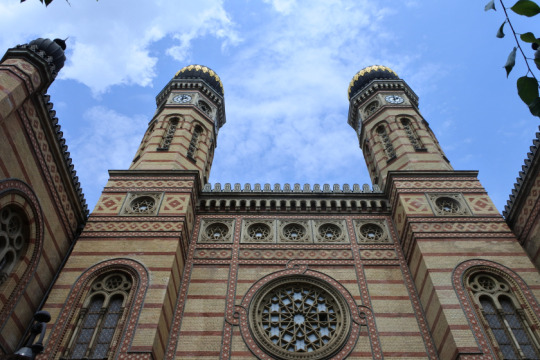
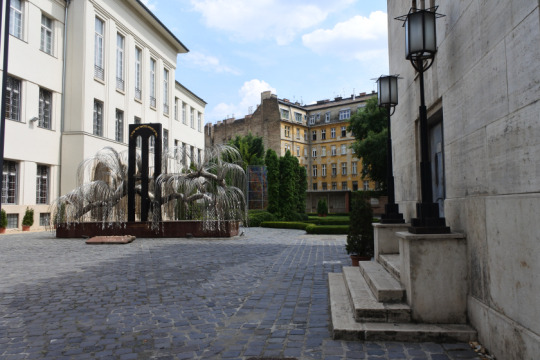
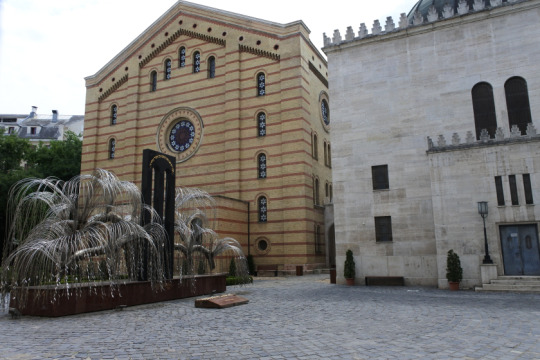
I’d say the district is my favourite part of the city – it is artsy, hip and young. It reminds me of London’s Shoreditch. I like the idea of using old stuff in a creative way and creating outdoorsy places, where people can socialise over a drink.
We visited very cool place – Szimpla – like a beer garden / bar open day and night. The definition of hipster place! Also, I bet it is great spot for live music in the evenings. No wonder is popular with tourists.

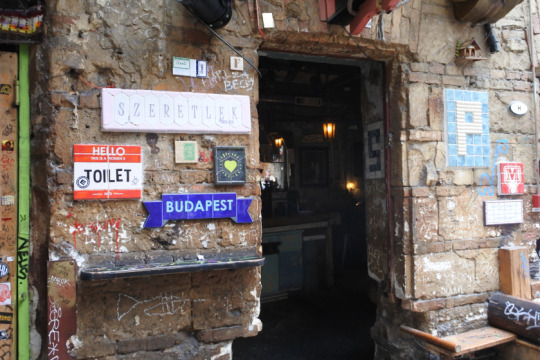
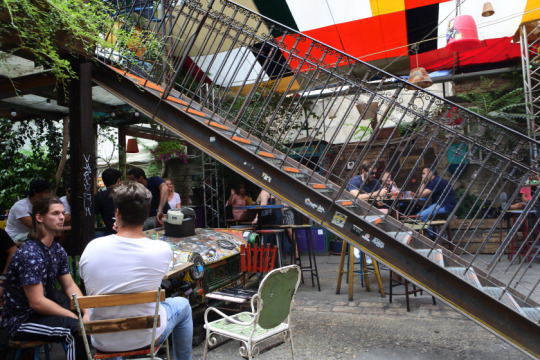

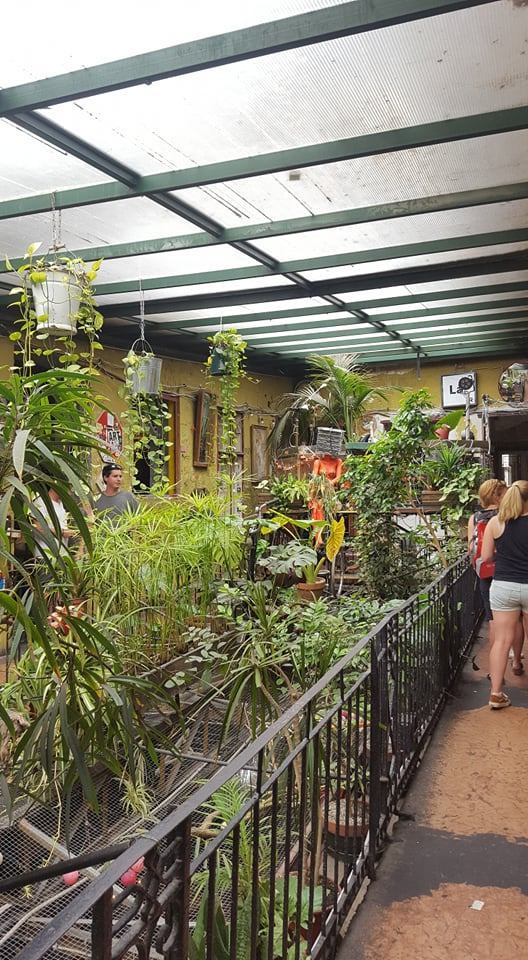

We enjoyed couple of Soproni pints (local beer) before moving on to the near by street food market Karavan. Here we tried the local “communist pizza” – Langos. You could also have touristy burgers and even vegan options are available. Karavan is a cool place, good to have local fast food and some beers.
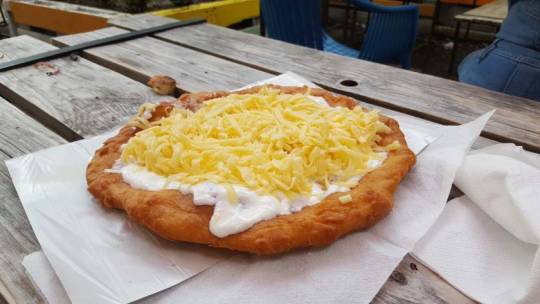

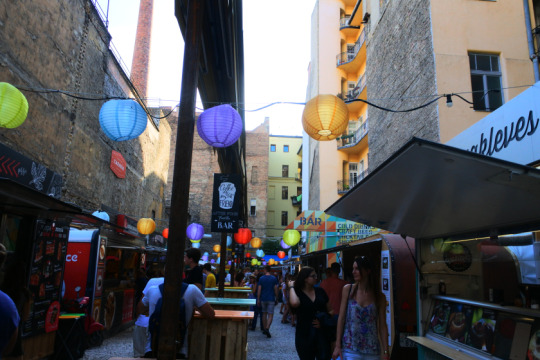
This area is also popular with the many bars, garden restaurants and night life.
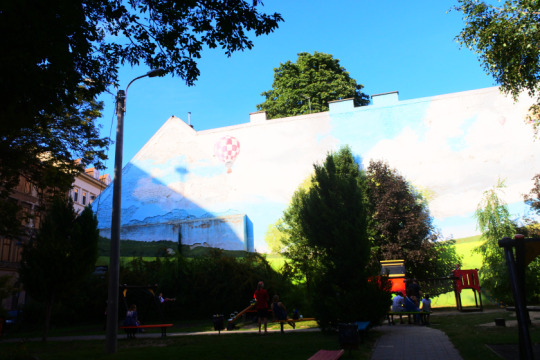

Thermal Baths
This is a must experience in Budapest! The city is known for its thermal baths and so I wanted to try at least 2 of them over my short stay. Baths are increasingly popular, and as I saw sometimes you have to queue to get in. I imagine this is annoying for locals because of queuing and higher prices. We visited 2 baths – Rudas and Szechenyi.
Night swim at Rudas Bath
Rudas is located on Danube bank, near the bridge. It has several sections – thermal baths, wellness and swimming pool. Entry is around 5100 F (or £15-£16). We tried out the night bathing from 22:00 to 04:00. It was busy Saturday night, and we queued for around 25 mins until we got it. The bath is well equipped with lockers, changing rooms, showers and laundry dryer.
The wellness part has 2 big pools with different temperatures – 26 C and 33 C (if I remembered correct). There are also 2 smaller pools – very cold and very hot 42 C. I tried to get in the hot one, and my feet was burning so I gave up on it. Some people manage to stay there for several minutes – admirable! I would feel like boiled chicken if I had to get it there! I was mostly in the bigger pools, which I thought are perfect place to have a nap whilst enjoying the jacuzzi effect. Really nice massage for your back or feet.
The thermal bath part on the other hand is located in an ex mosque. The mosque built in Ottoman times was regenerated and now its beautiful building is used as a bath. The night vibes are so relaxing – lights shadowing, beautiful ceiling and light blue watered pool. The bath here has 1 major pool (I assume it should be around 34 C).Once I felt hot, I was jumping in the other smaller pools – these are 4 more pools between 28 to 42 C. After hot pool, 28 feels freezing. Not to miss is the steam room too – how long could you stay in 50 C steam?
And the best bit of the bath is the rooftop! Smaller warm pool on the roof, with view towards Buda and Danube. It was beautiful! Imagine chilling there with a drink in the pool? A dream, and I quite enjoyed it. That night was even more beautiful as it was thundering and we could see the lightening in the sky from the pool. I am not sure how safe this is, but experience is worth it.
Szechenyi Bath
This bath is different – it is actually outdoors and is located outside the city centre, next to the zoo. The best way to get there is by Metro for several stops. Again, the bath is in a beautiful yellow building. It needs some renovation, however it still looks great. It has a swimming deep pool and 2 more big warmer pools. I spent my bday day there – sunbathing and chilling in all pools, trying out the bubbles and jacuzzi. Perfect place to float. Entry is again around 5400 F. There is also restaurant when you get hungry / thirsty.

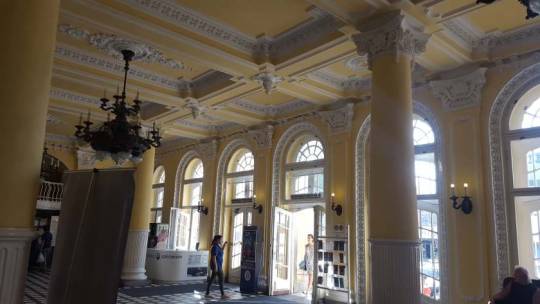
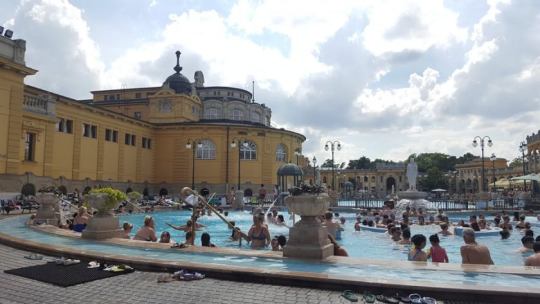
Speaking of food and drink…
Places to eat and drink
One flag here – Budapest city centre is full of Italian places. I love Italian food, however I would not eat it when in Hungary. To me – this is a tourist trap, and may suit well if you fancy pizza and burger (oh yeah, burgers everywhere). I am a fan of trying local dishes, so we were looking for places to have more Hungarian meals. Of course, in tourist areas prices are 3-4 times higher than the normal for locals. We were advised to eat in Pest, as Buda is more expensive and food is not greater.
So first – what is actually Hungarian food? Meat. Loads of meat. If you are vegetarian, or worse – vegan, you will struggle and you will not try locals meals.
Hungarian dishes
Goulash (Gulyás) – this is a soup with beef and paprika. The traditional version is soup, however tourists tend to have the stew version (which is the touristy option).
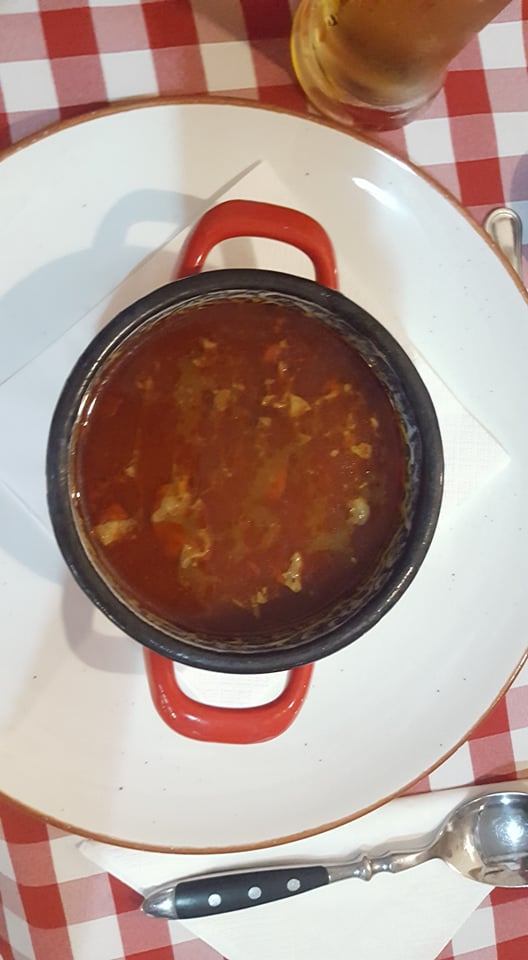
Paprikash – this is a stew with chicken, sour cream and paprika sauce, and also Hungarian version of dumplings. It is very tasty and goes well with red wine for dinner! Actually we have Paprikash in Bulgaria too, but ours is more tomato focused and no dumplings.
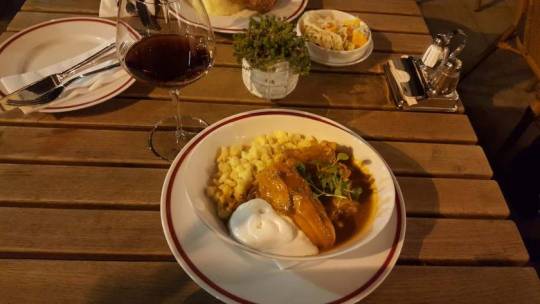
Langos – this is very popular street food. It is actually what Hungarian eat when drinking. It is fried fatty bread topped with sour cream and cheese. Other versions include paprika. I even saw Nutella Langos. It is very similar to our mekica – which we eat for breakfast.
Cake – Budapest has a plenty of bakeries or coffe houses and you can get delicious cakes. The traditional cake is a type of Sponge cake.
Hungarian drinks
Alcoholic on top of that.
Wine – Hungary is a wine region, so when visiting definitely try some loal wine. Red wines are particulartly good.
Palinka – Hungarian spirit, they say up to 70% alcohol. It tastes like fire. If you tried other Eastern European spirits like rakia you know what to expect 😀
Unicum – is a traditional herbal liqaur and they say is good to have a shot when getting a cold.
Where to eat?
Depends on your taste. We tried mixture of street places and nice restaurants.
Street food places – we tried Karavan market and the Central Hall Market. The Central Market has a range of grocery stands, souvenirs and up stairs it has several street food and Cafes. I got a chocolate truffle cake for 300 F and it was the best cake I had in town.
For breakfast, we tried to very good places: Kuglof and a French bakery Amber. At Kuglof I really liked the French toast with fried eggs and Paprika, and the massive chocolate latte. At Amber I gave a try to another chocolate cake.
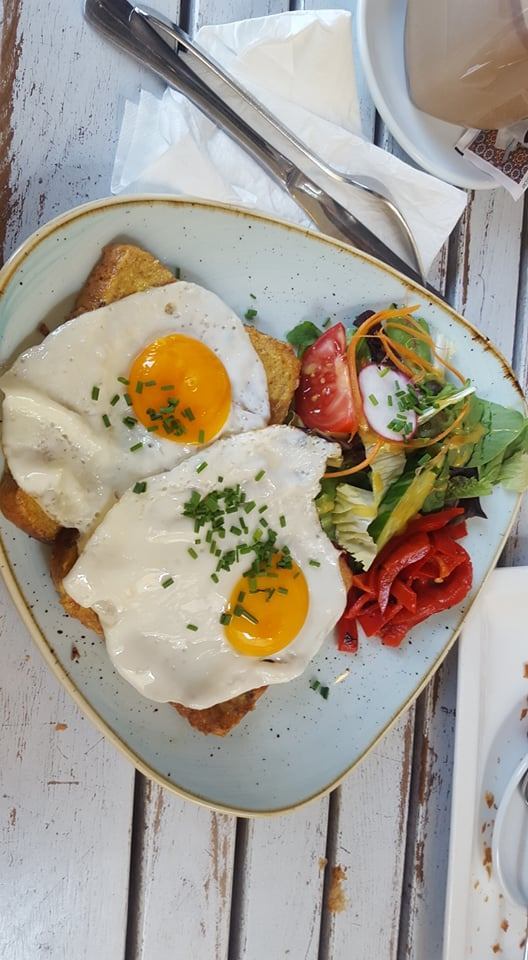
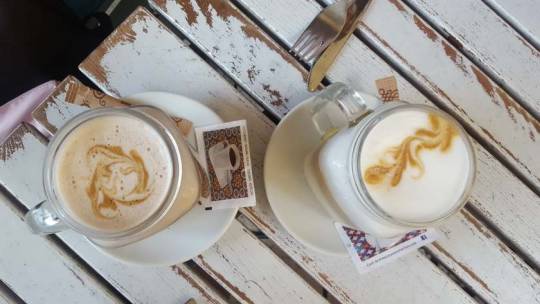

For dinner, I enjoyed soup guyash at Hungarian bistro. I also tried chicken paprikash at another garden restaurant Borze Kavehaz, which was pretty good. Portions here are quite big, so I was struggling to finish my meal.
Budapest is one of my favourite cities, and I will be back. I have always wanted to visit around NYE – as it’s beautiful and why not anjoy thermal bath again when cold?
Definitely great place for weekend trip and / or solo travel!
Weekend break in Budapest -this is why it’s a good idea! This year my friend and I have picked Budapest as the place to celebrate our birthdays. Great way to try something different and be away from London for couple of days.
#budapest#culture#danube#europe#food#hungary#paprika#thermalbath#tips#travel#walkingtour#weekendbreak
0 notes
Text
Healthy Body, Healthy Heart
It takes a lot to shock me, but I can’t deny I was literally taken aback yesterday to read that in a recent survey (conducted by Damart and Heart Research UK), 90% of women do not reach the recommended level of exercise each week. So only 1 in 10 females here in the UK are moving their body for the recommended 30 minutes per day, every day. I was shocked and to be honest saddened at this cold, hard truth – even more so when I read on to see than 8 out of 10 cases of coronary heart disease are preventable by avoiding smoking, an unhealthy diet, and a lack of daily exercise. In an age where exercise options have never been greater, nor healthy food more widely available, how can this have happened? In an effort to try to inspire women to get more active and help to change this shocking statistic, here are my top tips for females everywhere to boost not only their overall health, but specifically their heart health.
Photography by Anna Rachel.
These boots were made for walking
Or trainers, or ballet flats, or even flip flops if you prefer! Doesn’t matter what you’ve got on your feet – just use them. Walking is free and can be done literally anywhere and any time. It is one of the most under-rated forms of exercise which is such a shame when it burns calories, improves cardiovascular endurance and is accessible for everyone thanks to being low-impact. If finding 30 minutes a day to get on your feet is tough, then try to think of ways you can incorporate it into your daily routine. Do you drive to work? Why not park 15 minutes away from your office? That way you’ve got a 15 minute walk to and from your car every day. Have to drop your kids at school in the morning? Why not walk together rather than getting the bus? Or if the morning routine is tight, why not head to the park after school together and walk a few laps on the way home? If you get public transport to work, think about getting off a few stops earlier on the bus or tube and walking the rest of the way. And if you are on the tube or taking the train then forget escalators and lifts – take the stairs and use your feet! A lunchtime walk is a great idea if your job means you’re seated for much of the day. A half an hour stroll outside will get you away from your desk, allow you to be more mindful as you take in your surroundings, and energise you for the afternoon of work ahead. If your evenings are packed with social catch ups, consider making some of them on foot – you can still hear all about your friends new man or moan to them about what a slave driver your boss is as you walk and talk together. Why not get some matching T-Shirts printed so you even feel like a little team? Bulk t-shirt printing could be the answer!
Get fit in the comfort of your own home
Yes it’s true – in this digital age you can work out with some of the worlds’ best trainers…. without even stepping outside your front door. YouTube, Instagram and Facebook Live mean it is easier than ever to get access to literally thousands of different workouts from our laptops and phone screens (check out some of mine here) – so you don’t even need a gym membership or access to a swanky boutique studio to try out some of the latest fitness trends. From yoga to HIIT to boxing to Beyonce Booty Shaking – there’s an online workout video out there to suit you – start searching through YouTube to discover some channels and presenters with content that you like, and make your own YouTube playlist adding all your favourite workouts and classes – then you have your own workout library ready to go, without having to go anywhere!
Try Try Trial Again
So you don’t have the room to workout at home, or you’d just rather your flatmates didn’t hear you doing burpee after burpee on your bedroom floor? There are still plenty of places you can go and train, and the vast majority of gyms and studios will offer you a free trial class or period for you to check out their facilities and see if they work for you. So you can still get access to some of the best gyms and classes in your area, without the upfront financial commitment. Some studios will offer the first class for free, or a bundle or 2 or 3 classes for a special introductory price, so you can shop around, find out what works for you and get fit at the same time. Or why not check out your local leisure centre? Many are lucky to have had huge council investment meaning they have excellent facilities and a range of classes – but without the boutique studio price tag. They also usually offer a pay as you go option, so if you fancy Body Pump one day and a game of badminton with your boyfriend the next then your local leisure centre will offer that flexibility.
It Ain’t What You Do
To most people, when they think of exercise or physical activity, images of 5am bootcamps in the mud, gruelling 10k runs, or spinning classes where you end up drenched in sweat and unable to stand up after dismounting the bike tend to come to mind – but being active doesn’t have to mean pushing yourself until you need to vomit into the bin. Hitting the target of 30 minutes of physical activity every day could be done in a pilates class, swimming, playing tennis, salsa dancing, riding your bike…. and in hundreds of other ways. Of course in order to see improvements in fitness, strength and stamina you need to start to push yourself and your body – but for many this seems such a long way off, which is why it is important to realise that you don’t have to push yourself to the point of collapse for it to count towards your daily activity. In fact going from doing nothing to high intensity training is risky – and even gold medal winning athletes had to start somewhere. Moving your body is moving your body – so do it in a way that works for you – and that way you’ll be more likely to stick to it.
Goal Getter
In order to maintain motivation, it can be really helpful to have something to work towards. When it comes to fitness, often goals tend to be weight related, but I think the best goals are more about physical achievements – e.g. hitting 10k steps every day, being able to run your first 5k, performing full push ups etc. Why not set yourself a target to work towards so that your training has a focus? It is easier to track progress which in turn can help to keep you motivated, not to mention the satisfaction when you hit your target – and all whilst getting active for the recommended 30 minutes every day.
I truly hope that this tips will help to inspire you to get more active, and to help incorporate activity into your daily routine, not least because heart disease can affect anyone at any age, but they sadly women are more likely to develop heart disease than men. Heart disease CAN be prevented, and Heart Research UK advise that healthy eating and an active lifestyle are two of the best ways to do this. We may live in a world obsessed with statistics (number of Instagram followers, what celebrities earn, the number on the scale) but I truly hope that with simple changes in lifestyle that we can help reduce the 90% of women who currently don’t reach the recommended activity level. If you know someone struggling to hit their target, please share these tips with them, and get behind them to encourage them to get moving. It may just save their life.
The post Healthy Body, Healthy Heart appeared first on Wildcat Fitness.
from Healthy Body, Healthy Heart
0 notes